Giga Wheels
Bring Your Automotive Skills to the Next Level

Long Travel Suspension vs Lift Kit: 6 Differences [Must Learn]

Last Updated on March 13, 2023
Long travel suspension and lift kits are both modifications used to increase the off-roading capability of your vehicle, but they offer very different benefits.
The suspension kit offers superior performance for more wheel travel with safety, while a lift kit can give more ground clearance and is typically much easier to install and maintain.
Both provide a comfortable ride, better performance, and improved safety than before. When you compare wheel travel, installation costs, maintenance considerations, and performance capabilities, you can understand which suits your vehicle.
We’ll help narrow down all options based on budget, driving style, and lifestyle needs.
Table of Contents
Long Travel Suspension vs Lift Kit: Comparison Points Between Them

If you’re an off-road enthusiast, then you might be considering either a Long Travel Suspension or Lift Kit for your vehicle. Both provide distinct advantages and disadvantages, but in the end, it comes down to what provides the most value for your needs.
1. Wheel Travel:
Long travel suspension is popular among off-road enthusiasts because it provides more wheel travel than stock suspensions. This type of setup involves custom shocks, wider control arms, and other modifications that enable the wheels to travel further up and down.
This additional wheel travel helps improve articulation over rough terrain while providing better traction with the ground surface. Long-travel suspensions provide increased stability when driving over obstacles or large dips in the road since they don’t bottom out as easily as stock suspensions do.
A lift kit is another type of suspension modification that is designed to increase a vehicle’s ride height by adding lift spacers or longer shocks . The increasing ground clearance can allow vehicles to traverse rough terrain more easily without bottoming out on sharp rocks or logs.
Lift kits also allow for larger tires, increasing traction in certain conditions, such as mud or snow.
2. Performance:
Long travel suspensions offer superior performance when compared to lift kits due to their increased damping compression control and ability to adjust ride height, damping and spring rates according to personal preferences or terrain conditions encountered while off-roading.
Suspensions provide improved off-road performance with more suspension travel which allows drivers to speed up on rough terrain without sacrificing comfort or stability.
Lift kits, on the other hand, provide increased ground clearance but less control over terrain due to their limited suspension travel. They also reduce seating comfort due to raised center of gravity, which can be uncomfortable for some people during longer trips.
A lift kit is typically used for more casual off-roading or aesthetic purposes.
Long Travel Suspension provides improved off-road safety due to its dampening control and adjustability for optimal traction on different terrains. The added suspension travel also helps reduce the potential for injury from sudden impacts or jolts from rough terrain.
A Lift Kit might improve ground clearance but also reduce suspension travel and stability control, meaning that it may not provide the same level of safety as a long-travel suspension set up.
4. Installation:
Installing a long-travel suspension system is much more complex than installing a lift kit. It usually involves disassembling part or all of your vehicle’s existing suspension in order to modify it for the extended travel range.
Afterward, you will need to fit the new components, such as shocks and springs, followed by realignment once everything is in place. This process may take anywhere from hours to days, depending on your skill level and the complexity of the setup you choose for your vehicle.
With a lift kit, installation time can be significantly shorter since there is no need for disassembly or modification of existing parts. All you have to do is bolt-on or weld new components into place and perform any necessary alignment adjustments afterward.
5. Maintenance:
Long Travel Suspension requires more frequent maintenance due to increased suspension movement resulting in additional wear and tear on components, such as shocks, ball joints, and springs.
Lift Kit generally requires less frequent maintenance as it adds height without significantly affecting the vehicle’s performance. It is important to check regularly that all mounting hardware is secure, as well as pay attention to any signs of rusting or corrosion on any parts that are exposed to the elements.
The cost of a long travel suspension system is often higher than that of a lift kit due to the greater complexity and components required to achieve extended travel.
Long travel suspensions require several components such as shock absorbers, coil springs, sway bars, and lower control arms. The added components can add up quickly, resulting in an expensive installation cost.
On the other hand, lift kits are relatively cheaper since they only require a few parts such as new suspension blocks, brackets, and spacers.
Long Travel Suspension vs. Lift Kit: Which One Should You Install?
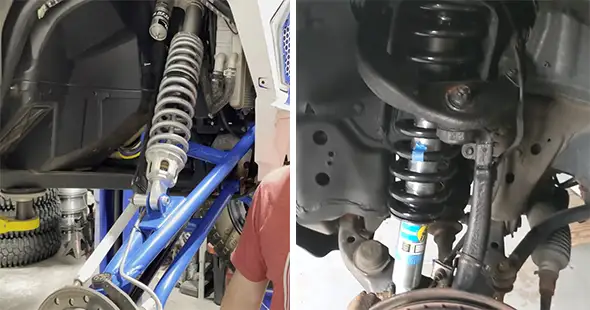
The question of whether to mount a long travel suspension or a lift kit on your vehicle is an important decision to make. Both options offer distinct advantages and disadvantages depending on your desired outcome.
A long travel suspension is an ideal choice for you for maximum wheel travel, superior performance, and improved safety due to the added stability it provides when navigating off-road terrain.
Conversely, a lift kit offers ease of installation and fast results, with the ability to maintain consistent reliability at a fraction of the cost.
Ultimately, both methods are equally viable for increasing ground clearance on your truck, but you should assess your situation carefully before making your final selection.
Is Long Travel Suspension Worth It?
Long travel suspension is worth it for many reasons. It can provide riders with a faster ride by keeping their tires planted and improving traction than mid travel suspension and lift kits.
In some conditions, such as rough terrain or high speeds, a long travel kit can be beneficial in reducing the impact of bumps and shocks on the rider. A long travel suspension kit can increase stability at higher speeds and provide a smoother ride overall.
How Much Does It Cost to Install a Long Travel Suspension?
The cost of installing a long travel suspension will vary depending on the type of bike and components being used, but generally speaking, it can cost anywhere from $5,000 or more.
Installation costs depend heavily on the quality of parts chosen as well as labor costs incurred by your local bike shop or mechanic. It’s also important to keep in mind that if you choose to upgrade parts down the line, such as upgrading your shock absorber or fork, you may need to pay additional fees for installation.
What is the Most Comfortable Suspension Type?

Air suspension is often considered to be the most comfortable type of bicycle suspension. It has the ability to easily adjust and respond to different terrain types without sacrificing comfort or performance.
The air-spring design provides riders with greater control over their ride quality by allowing them to adjust rebound damping according to personal preference. Air springs also offer an improved weight-to-stiffness ratio compared with coil springs which makes them perfect for both trail and cross-country riders looking for a comfortable ride experience.
Is 150mm Travel Suspension Too Much?
It depends on what type of riding you plan on doing and what size stanchion your bike has. Pushing the limits of what a 34mm stanchion can deal with will mean that 150mm of suspension travel could be too much for this frame size in terms of stability and durability in rough terrain.
For trail bikes with aggressive rides, a sweet spot for suspension travel would usually be 130-140mm since this provides enough cushioning while still maintaining good stability when going through more technical sections of trails.
Does 10mm of Travel Suspension Make a Difference?
10mm of travel suspension does make a difference. This extra “travel” is the distance the suspension can compress and expand, which provides different levels of cushioning for different terrain.
With 10mm of travel suspension, you will notice more control when riding on uneven terrains such as rock gardens, steep inclines, or sudden drops. It also allows for more margin for error when taking technical roll ins or drops and reduces bottom outs, giving you greater confidence to push your limits.
Does Long Arm Suspension Ride Better?
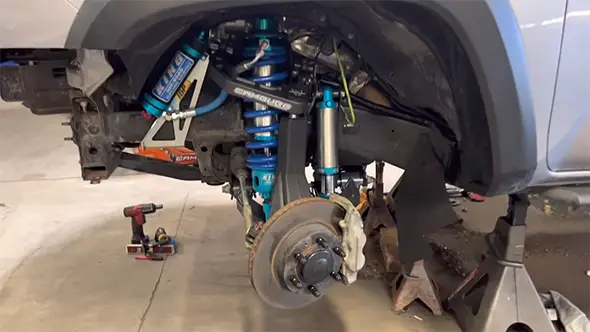
Long arm suspension typically rides better than short arm suspension and body lift kit. It helps to smooth out the ride while providing additional clearance and travel potential.
The longer arms reduce operating angles which place stress on the vehicle’s components and reduce its ability to flex and conform to the terrain. When placing longer control arms, they help to increase ground clearance and off-road agility while reducing vibrations on gravel roads.
What is the Most Durable Suspension?
The most durable suspension is Rigid Axle Suspension (also known as beam axle suspension). This type of suspension has an axle that runs perpendicular to the vehicle and is connected to the wheels via a wheel spindle combined with springs that bear a lot of loads.
It offers excellent space efficiency compared with other types of suspensions which makes it ideal for offroaders who need maximum durability over long distances. Rigid axles also provide better articulation due to their higher load bearing capacity, allowing vehicles with this type of suspension increased maneuverability in rough terrain.
Make the Most of Off-Roading with the Right Upgrades
Both Long Travel Suspension and Lift Kits can provide an improved driving experience . Choosing the right suspension system or lift kit for your off-road vehicle can be difficult without a deeper understanding of what each option offers.
Long travel suspension provides increased wheel travel and improved safety & performance, but they can also come with higher installation costs and maintenance requirements.
Lift kits are cheaper , easy to install, and provide increased ground clearance, but they lack the same performance as long travel systems.
As always, keep in mind your personal preferences as well as the condition of your vehicle when upgrading your vehicle with lift kits and long travel suspension.
Leave a Reply Cancel reply
Your email address will not be published. Required fields are marked *
Save my name, email, and website in this browser for the next time I comment.

- Get Started
- Accessories
- Acc Lighting
- Front Bumpers
- Rear Bumpers
- Rock Sliders
- Skid Plates
- Trail Tested
- Maintenance
2nd Gen , 3rd Gen , Lift Kits , Long Travel , Off-Road , Overland , Suspension
8 best long travel kits for the tacoma.
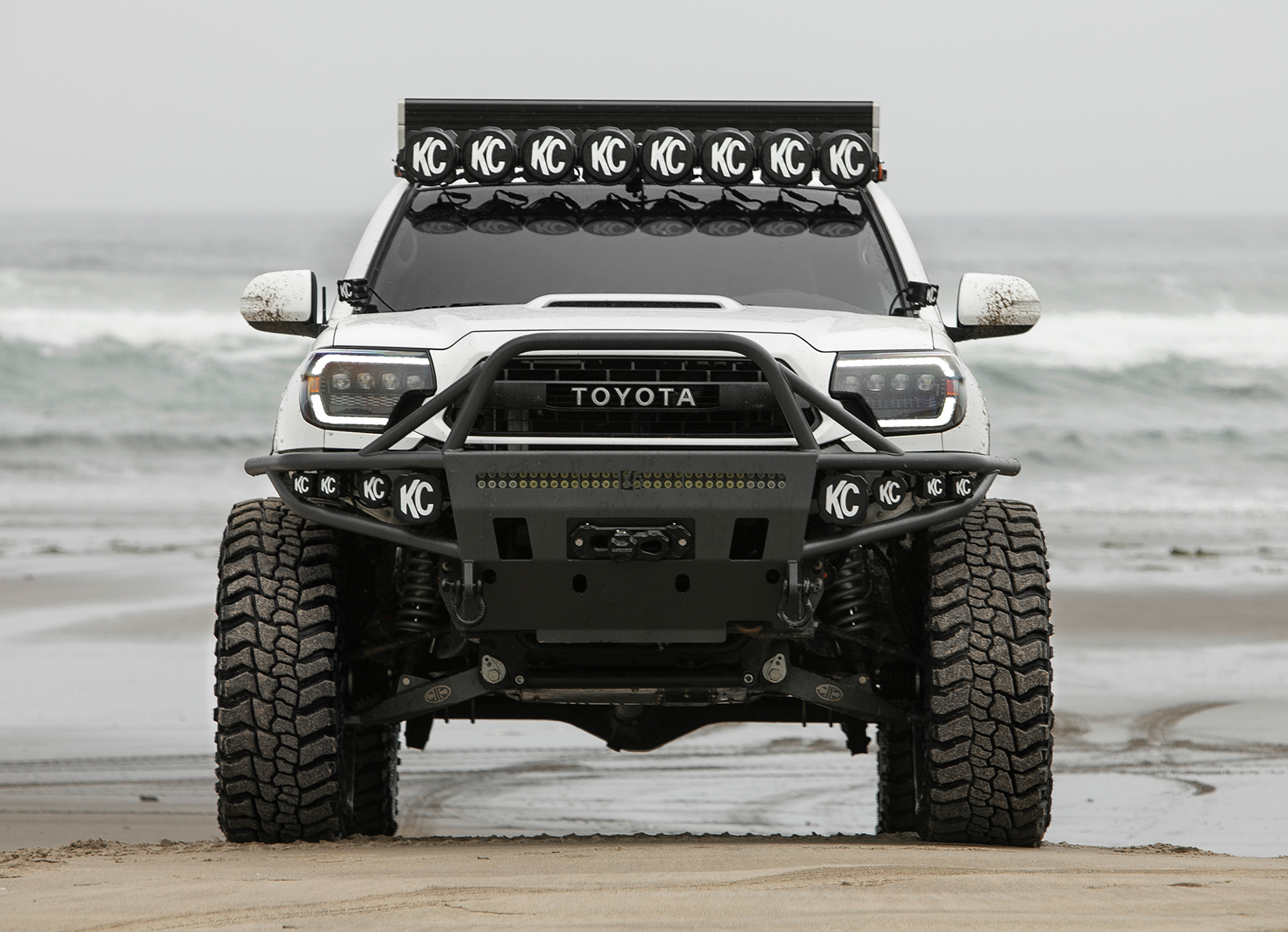
When it comes to long travel (LT) suspension on the Toyota Tacoma, you have many options to choose from. You don’t have as many compared to mid-travel lift kits and leveling kits , however, there is an LT kit out there for everyone’s needs.
Before we get into the specifics of a long-travel suspension and the offerings on the market, it’s important to understand what long travel is and why you might want to add this type of suspension to your Toyota Tacoma. Long travel isn’t for everyone as it’s rather expensive depending on the parts you’re running and designed for a very specific style of off-roading.
Long travel kits are designed for go-fast and rock crawler builds looking for more articulation (wheel travel) from their suspension. We will touch on the differences later but first, let’s learn the terminology.
Table Of Contents
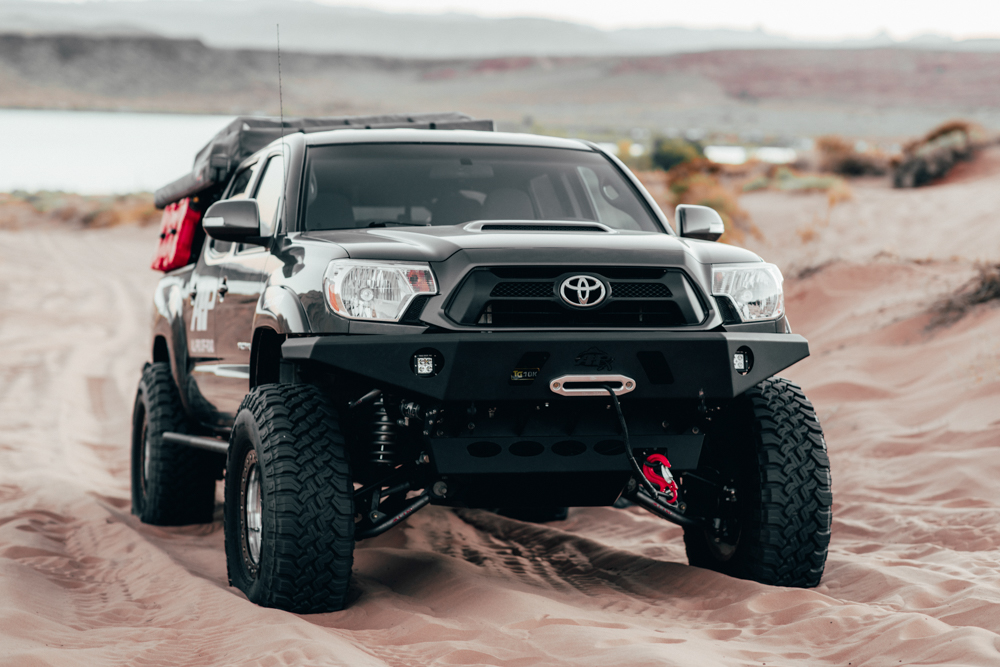
- LCAs and UCAs: The foundation of what’s considered “long travel” starts with your A-arms; LCAs (lower control arms) and UCAs (upper control arms). Your lower and upper control arms push the wheels farther away from the vehicle’s center frame and are measured in inches; 1″, 2″, 3″, and beyond. Aftermarket A-arms can be boxed or tubular, are made of Chromoly, aluminum, and/or steel depending on the brand. Lower control arms often add internal gussets for increased strength and tube style upper control arms add external gussets for added strength. Long travel a-arms are typically configured with heim joint or bushing pivots at the frame/shock bucket and uniball joints or ball joints at the spindle knuckle pivot however some companies offer uniball joints for both.
- Coilovers: The primary shock used for LT starts around an 8″ stroke and at least a 2″ body, however, most are 2.5″ body shocks. If you’re not running secondary bypass shocks, you want coilovers that offer remote reservoirs and compression/rebound adjusters.
- Secondary Bypass Shocks: Bypass shocks are designed to handle compression and rebound damping. With secondary bypass shocks, you don’t need compression and rebound adjusters on your primary coilover, but you can run them. Secondary shocks usually range from 2.0″ to 3.0″ wide.
- Shock Hoops: Tubular hoops with shock mount tabs welded to the frame are designed to hold the secondary bypass shock to the lower control arm.
- Shock Stroke: The measurement of how far the shock shaft enters the shock body between full extension (droop) and full compression (bump). Long travel shocks usually range in lengths of 12″ – 18″ for the rear and 8″ – 10″ for the front.
- Remote Reservoirs: Remote reservoirs help to dissipate oil heat in the shock body when the suspension is cycling. Remote reservoirs can contain a larger volume of oil which helps prevent the shock from overheating and allowing for more consistent damping.
- Bump Travel: When the shock compresses in an upward motion. Also known as up-travel.
- Droop Travel: When the shock rebounds in a downward motion. Also known as down-travel.
- CV Axles: Extended and typically stronger CV (Constant Velocity) axles push the knuckles farther from the center frame and oftentimes offer more articulation than factory CV axles.
- Brake Lines: Extended soft brake lines help to prevent snapping brake lines when the suspension cycles at full droop.
- Tie Rods: Extended and stronger steering rods connect your steering rack to your knuckles.
- Rod-Ends: High articulation heim joints that connect steering knuckles to the tie rod and the tie rod to the steering rack.
- Steering Clevis Kits: The steering rack clevis/bolt assembly threads into the steering rack which connects to a heim join that’s connected to the inner tie rod.
- Bump Stops: Either extended height rubber bump stops or welded-on brackets for hydraulic bump stops (usually hydraulic).
- Bump Stop Cans: Metal cans welded to the frame that hold hydraulic bump stops in place.
- Fiberglass Fenders: Extended height and width fenders allow tires more up travel clearance.
- Limit straps: Straps that prevent the suspension from overextension at full droop.
- Bed Cage: Bolt-on or welded cage in the bed of a truck designed to be mount points for rear 14″ – 16″ shocks. Bed cages hold spare tires, jacks, and other Prerunner accessories among other benefits.
- Spring Under Axle (SUA): Leaf springs are set on perches underneath the axle. Usually provides more bump travel over SOA.
- Spring Over Axle (SOA): Leaf springs are set on perches on top of the axle. Usually provides more ground clearance over SUA.
Define “Travel”

Define Travel
Travel is determined by the amount (in inches) of the distance between full droop (down-travel) to full bump compression (up-travel). Usable wheel travel is when all your suspension components work together creating a full range of motion. You can measure wheel travel by removing your shocks and cycling the suspension from full droop to full bump. Factory travel differs on many makes and models, however, 8″ is average for the Tacoma. Companies that offer long travel for the Tacoma quote anywhere from 10-14″ of usable wheel travel.
Shock Travel Vs. Shock Stroke?
Oftentimes travel is confused with the shock stroke measurement. Shock stroke is a measurement of how far the shock shaft enters the shock body between full extension and full compression.
Factory Travel Vs. Mid Travel
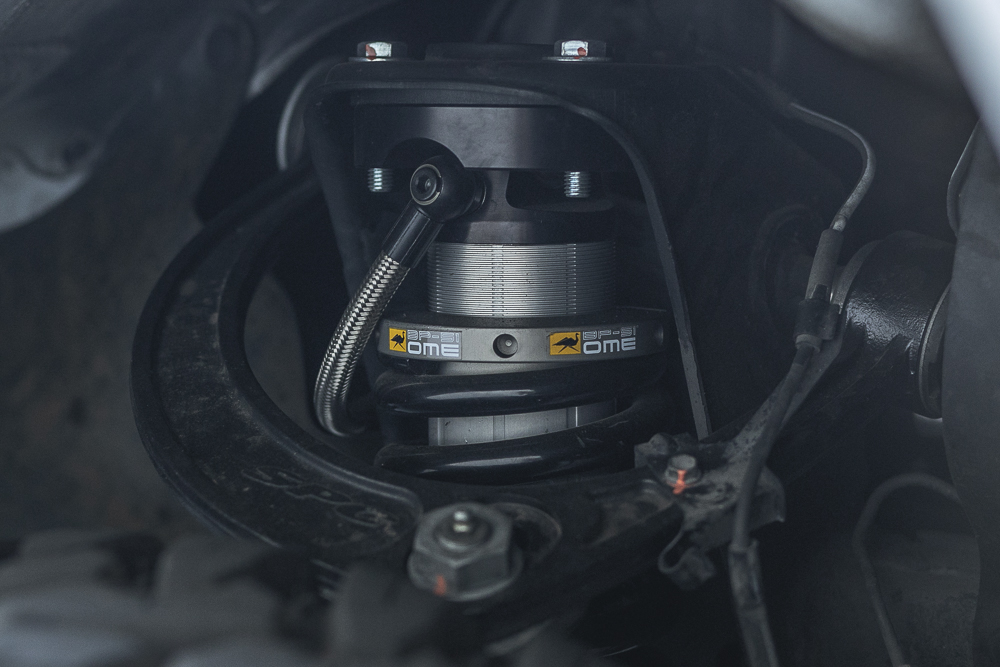
Pictured: ARB BP-51 Mid Travel Coilovers
Factory or “stock” travel is the amount of wheel travel you have from the factory, usually around 8″ for the Toyota Tacoma.
What Is Mid-Travel?
Mid-travel is a term used to describe a suspension that increases factory travel with extended-height coilovers that feature taller and wider shock bodies that are threaded/ adjustable for ride height. These kits are often paired with aftermarket UCAs (upper control arms) with built-in positive caster to reflect/correct the alignment change after lifting the Tacoma.
Sometimes mid-travel suspension kits are often mistaken with other coilover set-ups as the terms are intertwined. For example, just because a coilover is adjustable doesn’t mean it’s mid-travel. The Bilstein 5100 is a perfect example – it’s adjustable but definitely not considered mid-travel. The Bilstein 5100 kit and similar lift/leveling kits/shocks are simply referred to as such; lifts and leveling kits. I would refer to this style of lift as an “entry-level” lift kit and sometimes these upgrades don’t lift your Tacoma at all, guys just upgrade shocks for factory ride height.
Where entry-level lift kits are physically lifting your truck and mildly increasing performance (0″-1″ added wheel travel), mid-travel suspensions are not only lifting but providing much more control and drastically increasing performance (1″-2″+ in added wheel travel). You can compare these to long travel lift kits that usually result in 3″-5″+ in added wheel travel.
Good examples of entry-level suspension kits would be the OME Nitrochargers , Eibach Pro-Truck Lift kit , and again the Bilstein 5100 kit linked above. Good examples of mid-travel setups would be the OME BP-51s and kits like the Fox DSCs, Kings, Icon extended travel stage 2 kit, Bilstein 8112s, and many others.
With mid-travel, you’re changing the factory suspension greatly but there’s still room for more travel.
If you want to push your Tacoma faster and harder than mid-travel allows, a long-travel suspension is likely the next step.
What is Long-Travel?
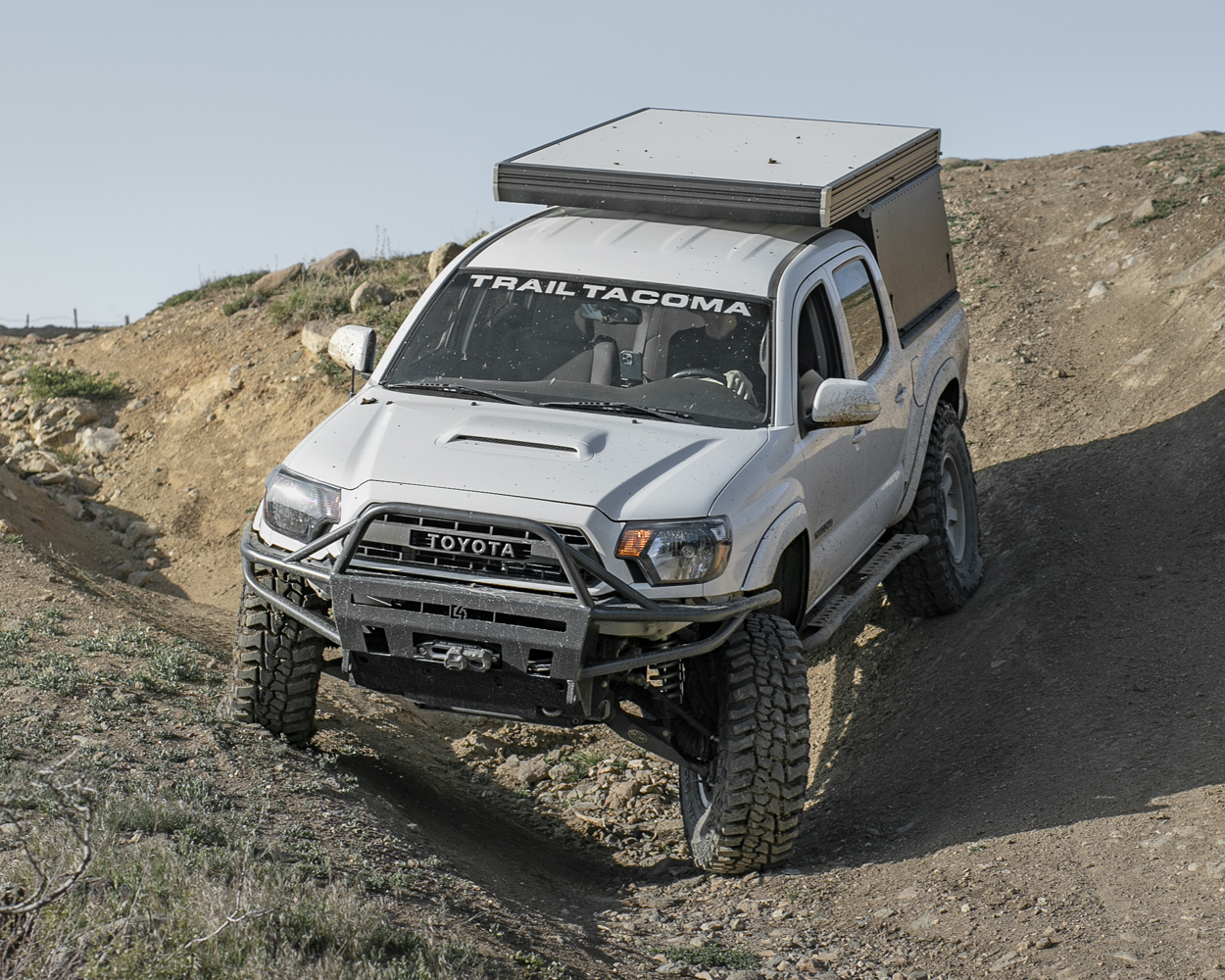
What Is Long Travel?
Long travel suspension is when you increase the length and/or height, and often the strength of your factory suspension components beyond the limits of your factory suspension geometry. Compared to mid-travel, long-travel suspensions provide even more wheel travel.
Where mid-travel kits feature extended-length coilovers and aftermarket UCAs to correct caster, long travel kits contain many more parts. In a typical LT kit, you see extended-length UCAs, extended-length LCAs, larger coilovers (typically an 8″ stroke to start), secondary bypass shocks, extended-length CV axles, extended brake lines, extended tie rods with strengthened rod ends, extended (both height and width) fenders, extended bump stops to prevent bottom out, limit straps to prevent top out, and more.
See how many times I listed “extended”? With long travel, everything is longer/wider, and stronger.
With LT, shocks usually range in shock strokes from 8″-12″ for the front and 12″-18″ for the rear.
How Much Travel Do You Need?
Where 4″ of up travel and 4″ of down travel is the standard of most Tacomas. 6″ of up and down travel is a good starting point to look at when it comes to LT. For go-fast rigs, the priority should be on up travel whereas rock crawler rigs focus on both but less on up travel.
Go fast rigs want about 60%-70% more up travel whereas rock crawler rigs want about 30%-40% up travel, however, this is not always the case and you should engage the company you’re considering to determine what’s best for your build.
Example – Go fast Tacoma with 12″ of total travel in the front:
A go-fast long-travel Tacoma should aim for 7″ up travel and 5″ down travel.
For the rear, up travel should be 25% more than the front. Take 25% of the 7″ front up travel and add that to the rear up travel.
If 25% of 7″ = 1.75″ we want our rear up travel to be at least 8.75″.
Travel Distance (Wider per side)
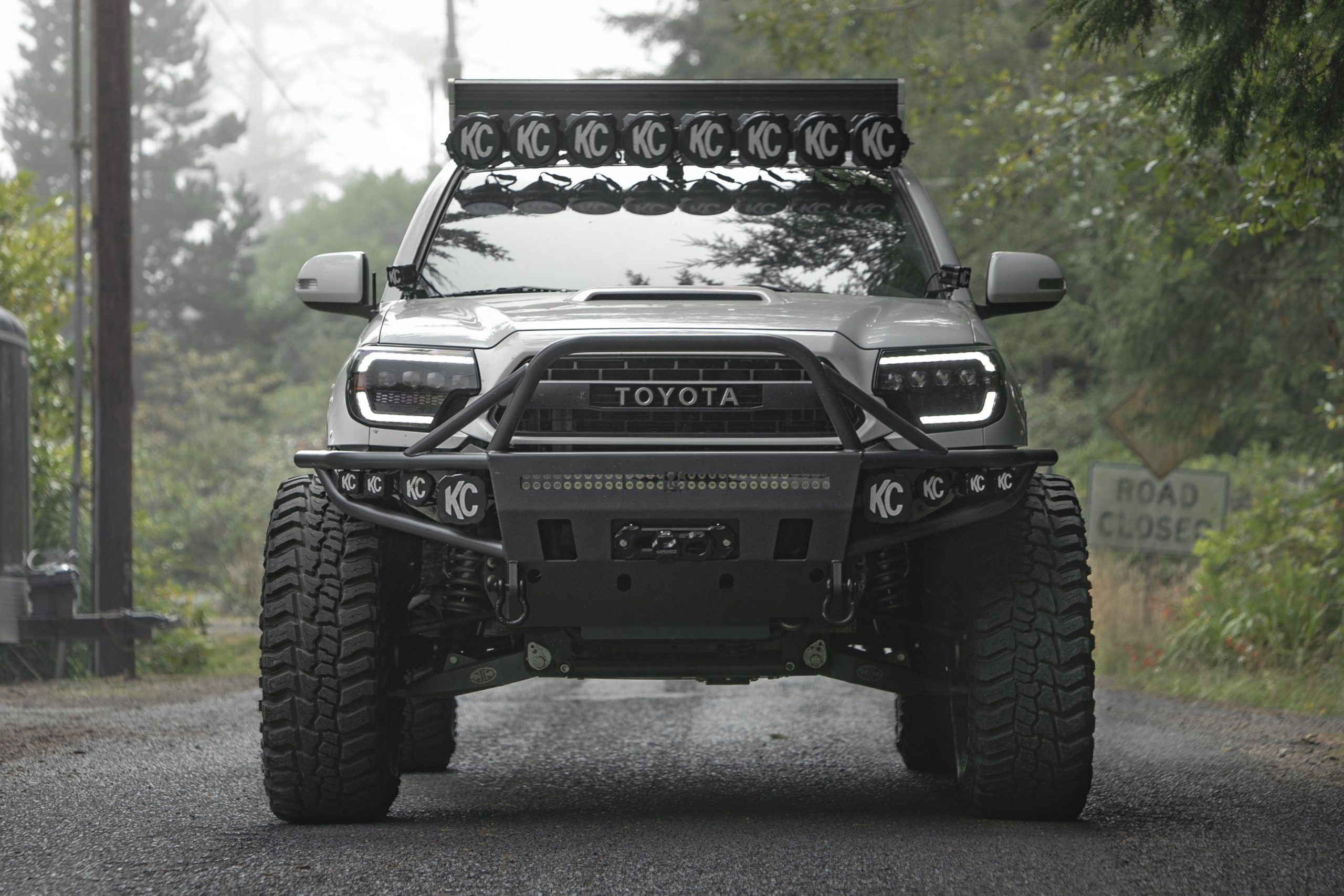
+2″ Vs. +3″ Vs. +4″ – which distance should you choose?
Long travel is measured by “per side”. When you see a +2″ kit, that’s 2″ wider per side creating a track width of +4″ overall.
2″ Class
2″ kits are usually the “stage 1” of LT, also referred to as “Prerunner” kits, ranging from +2″ and up then typically scaled in 1/4″ measurements; +2.25″ and/or +2.5″, etc. The +2″ class kits yield anywhere from 11″-13″ of usable wheel travel. In this class, companies make many great options. For example, Total Chaos offers a standard 2″ kit and an expedition 2″ kit. The expedition kit offers 2 more inches of ground clearance over the standard 2″ kit. So even though a kit is marked as a 2″ long kit doesn’t mean they all boast the same specs. Also in this class, Camburg makes a 2″ Trail Series kit that’s designed around tight trail use and to perform well for daily driving all without needing to upgrade fenders. There are many other 2″ kits on the market but one that stands out is the JD Fabrication 2.25″ kit that pushes upwards of 13″ of wheel travel and also features a slew of additional upgrades. With 2″ LT you don’t always need fiberglass fenders but a mild 1″ flare is recommended. If you avoid fiberglass, you will need to trim your factory fenders to see clearance at full compression (bump travel). This class is designed for daily drivers and weekend warriors, especially with something like the 2″ Trail Series from Camburg.
3″ Class
Next, you have 3.5″ kits and these are typically considered race kits commonly featuring uniball joints over ball joints. In the 3″ class, Total Chaos offers two versions of their 3″ class; the standard series and the race series. The race kit offers 2.5″ more ground clearance and is 5 pounds lighter per lower arm than the standard series. TC offers both poly bushing uppers and/or heim joint uppers. Both kits pull about 12.5″ of wheel travel. Also in the 3″ class, you have Dirt King. Dirt King offers their signature kit with bushing uppers and/or heim uppers yielding around 13.5″ of wheel travel. DK also offers kit-specific 4340 Chromoly axle shafts and/or prebuilt axles with factory Tacoma joints. Finally, you have Camburgs 3.5″ Race Series kit which is similar to the TC and DK kits, although it does stand out quite a bit in their overall offering which we’ll get into below. There are so many great options in the 3″ race class. With 3″ LT you will need fiberglass fenders; at least a 3″ flare and 2″ rise. This class is meant for hard-core weekend warriors who go out often and want to push the limits in the desert and/or in the rocks.
4″ Class
Last but not least, you have the 4″ class. This is a bit overkill for most but is very impressive nonetheless. With kits such as the LSK 4.5″ and the JD Fabrication 4″, you can get into the most advanced and race-focused rock and/or crawling-focused IFS long travel kits on the market. Most advanced doesn’t always mean best though. With 4″ class LT, you need large flare + rise fiberglass fenders, and all the suspension components are very custom; axle shafts, steering rods, brake lines, limit straps, shocks, bump stops, and even fabricated spindles that allow even more up/down travel. In this class, most kits come with everything you need because everything is such a custom length. Extending your track width out 4″ per side or even 4.5″ per side is a lot. This class is designed for someone who is looking to hit the ultimate send button on dunes.
UCAs & LCAs
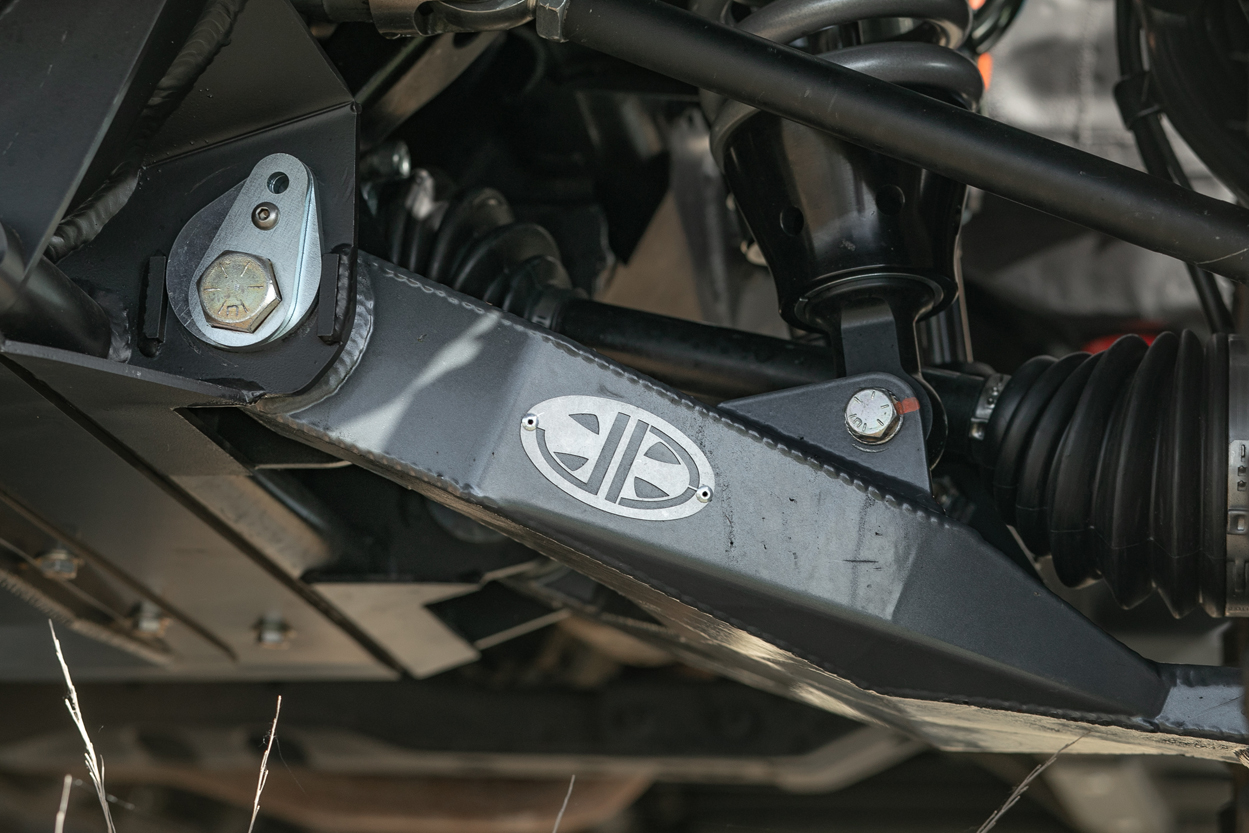
Not all uppers and lowers are created equal and long travel all starts with UCAs and LCAs. Here are a few key elements to look at when shopping for lower and upper control arms.
LCA Ground Clearance
An important item to consider when shopping for lower arms is clearance. Camburg uses a uniball adapter that goes under the uniball joint which positions the arm lower and actually offers less ground clearance than the factory. Dirt King and Total Chaos, for example, use the factory ball joint cradle so the lower arm goes above the joint which offers similar or even better ground clearance than the factory depending on tire size and other variables. For go-fast applications, ground clearance might not be as important for you. However, for rock crawling, ground clearance is very important. Pay attention to where the lower arm mounts to, on, or around the ball joint adapter.
LCA Front Slant
A slanted front surface for sliding over obstacles is very important for all drivers to consider, both go fast and rock crawling. Dirt King, Camburg, and JD Fabrication all offer a slant on the front of their LCAs. Pictured in the image above, you will see the JD Fab lowers with an aggressive slant on the face. Total Chaos, Marlin Crawler RCLT, and LSK on the other hand feature a completely boxed design with a flat front surface – not good for sliding over obstacles.
LCA Frame Pivots
Most companies such as Total Chaos uses polyurethane bushings at the frame pivot points. Dirt King, for example, uses Delrin bushings while JD Fabrication and Camburg both use 1″ uniballs. JD Fabrication takes it a step further and adds seals to their uniballs. Both the Derlin bushings and uniballs are going to offer a stiffer joint than poly bushings. Having stiffer joints is nice when you have 20%+ more leverage pulling/pushing on the frame pivots. With uniball joints, you have a wider range of alignment specs to increase your positive caster. Polyurethane bushings tend to squeak over time and don’t hold up well under extreme weather conditions.
LCA Wheel Placement
Some lower control arms have a positive caster spec and/or forward tire mounting built in. This is where you need to call each company you’re considering to ask whether or not they have a positive caster built into the arms and if not, how much room there is for adjusting the caster or pushing the wheel forward altogether. Dirt King, for example, has a positive caster spec built in, and so does JD Fabrication however JD goes a step further with its design. JD Fabrication builds cam tabs that allow forward positioning of the arm up to 7/8″ and that’s adjustable in increments of 1/4″. No one else offers that.
A major item to consider for UCAs is the uniball or ball joint and the cup. On vertically positioned uniballs, up travel is limited at the uniball cup colliding with the inner wheel well, and down travel is limited at the uniball colliding with the uniball cup. UCAs with an aggressive uniball cup slant will typically achieve more down travel. Pay attention to this slant on the UCA cup when purchasing UCAs.
UCAs from the LSK and Marlin Crawler LT kits, on the other hand, feature high-articulation horizontal uniballs. The down travel is now limited by limit straps and the up travel is limited by your tires depending on size. There is no doubt that high articulation horizontal uniballs on UCAs offer more up/down travel, however, this is highly dependent on tire size and other suspension components.
UCA Caster Correction
Because the Tacoma upper control arm is mounted from the factory in a different plane than the lower control arm, as you lift or lower the truck the caster changes. The more you lift the truck the more caster you lose. This is why it’s always recommended to add a “caster-corrected” upper arm when you lift a Tacoma. Most of the companies on this list all make caster-corrected UCAs, however, if you move forward with a kit, do your research first.
Uniballs Vs. Ball Joints
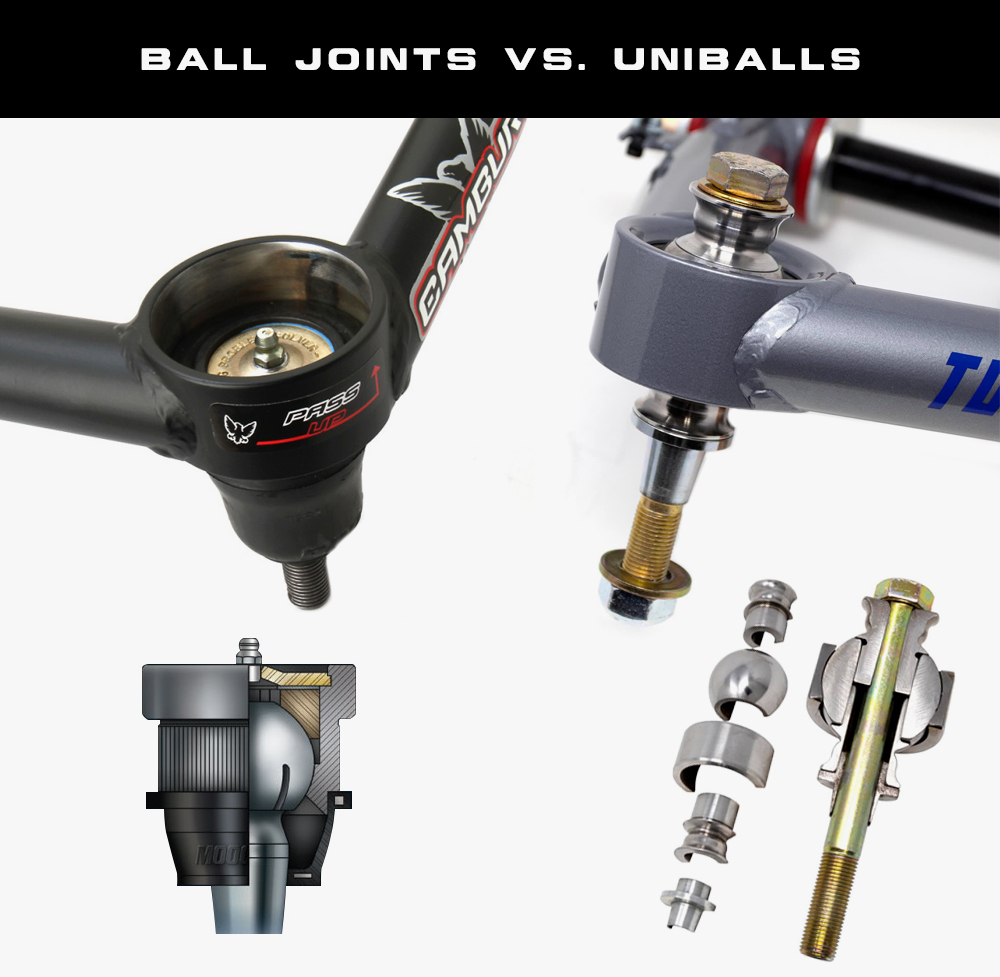
Camburg & Moog Ball Joints (left) and Total Chaos Uniballs (right)
The choice between uniballs and ball joints has long been a debate, although both have some noticeable differences over factory joints.
Uniballs are known to have more articulation than traditional ball joints which is nice when you’re looking for the most possible travel from an LT setup. On top of offering an impressive range of motion, the uniballs architecture is stronger than that of a ball joint. Uniballs do require maintenance though and if neglected – over time they can start to squeak, and/or become loose. Because uniballs are typically stronger and offer the most articulation, they are used on most builds for professional race classes like Ultra4.
Ball Joints
Ball joints on the other hand were designed for the daily drivers of today’s world. Unlike uniballs, ball joints are a sealed architecture and therefore require less maintenance. Some will say that ball joints have less articulation than their counterparts, however many companies like JBA offroad claim a full 90 degrees of motion, and other companies that feature an aggressive uniball cup slant can also achieve high articulation with ball joints.
Sealed Uniballs
JD Fab uses its own solution which is the best of both worlds. They have custom EMF joints made with the factory Tacoma taper machined into the pins. An EMF joint is identical to a uniball in design however it’s built in a way to be completely sealed from the elements. The design gives you all the strength and articulation of the uniball while offering the sealed, maintenance-free design of a standard ball joint. They are also easily rebuildable which is a huge cost savings compared to replacing uniballs.
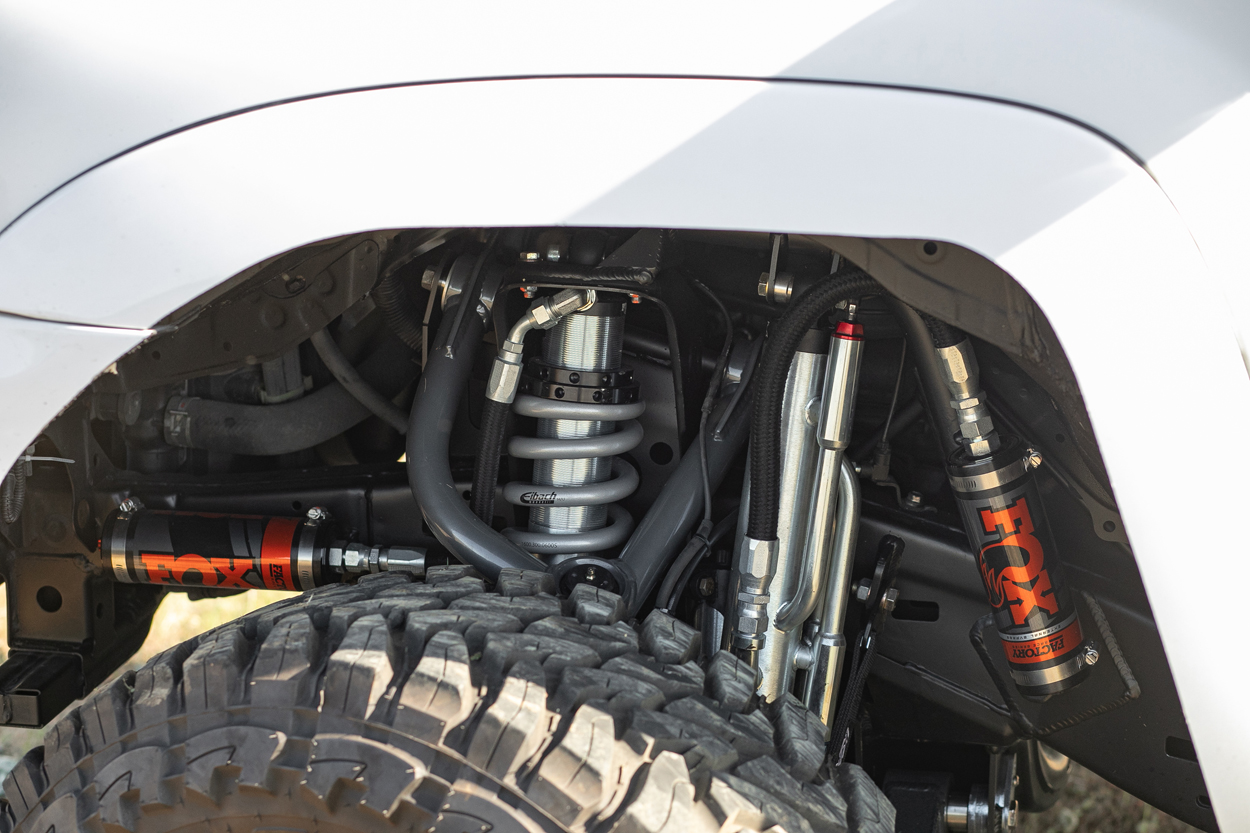
You have many options when it comes to shocks; King, Fox, Radflo, Icons, ADS, etc. They all make shocks for LT suspension setups although King and Fox tend to lead the race. Fox is actually the largest shock manufacturer in the world. They make shocks for many applications and Tacoma applications are no exception. King also dominates the Tacoma market and is known for producing some of the highest-quality race shocks on the market. Regardless of which you choose, you can’t go wrong with either brand. There is a reason why every major LT manufacturer pairs their kits with either King or Fox; they’re both very dependable race shocks, although Fox is slowly gaining more Tacoma traction. Compared to other shocks, Fox uses higher-quality seals, shock oil, and shafts. Fox is also more expensive than King, but again both are great choices.
There are many types of shocks that can be used for a long travel setup; coilovers, bypass shocks, piggybacks, and smoothie shocks.
Coilovers & Bypass Shocks (Front)
Companies that make an LT kit usually spec very specific shocks for that kit. For example, some companies lean on Fox and some on King. Some companies adjust the valving for those shocks in-house, and some outsource it or they’ll even pair the kit with Toyota OE shocks. That said, most will spec an 8″ stroke with reservoirs along with an 8″ stroke on the secondaries, also with reservoirs. For most LT suspension kits, an 8″ stroke is plenty of shock travel for the front of the Tacoma running a +3″ kit or under. If you can, order the shocks that the company recommends because they are often tuned specifically for that kit.
Reservoirs & Adjusters
Reservoirs along with compression/rebound adjusters are an added bonus on all shocks. If you plan on pushing your limits and going fast, then reservoirs will help to keep your shocks from overheating. Adjusters are going to offer adjustments for stiff or loose piston stroke which means you can adjust them to be stiff while on road and loose while offroad. Adjusters are great for someone who plans on using the truck as a daily and weekend wheeling.
Double Shear

Double shear is defined as twice the shear force breaking strength. So for example, let’s look at double shear steering on the knuckles. In a factory steering setup, the tie rods’ rod end is connected to the knuckle with one bolt on one mounting surface (single shear). With double shear, a single bolt is still used, however, you sandwich that bolt between two surfaces (double shear). Now instead of one surface resisting the load, you have two surfaces. The bolt in double shear will have twice the shear strength of a bolt in single shear.
When it comes to long travel, many components are upgraded to double shear; inner and outer rod ends for steering, UCAs on the coil bucket, secondary shocks, and more.
Steering Rack
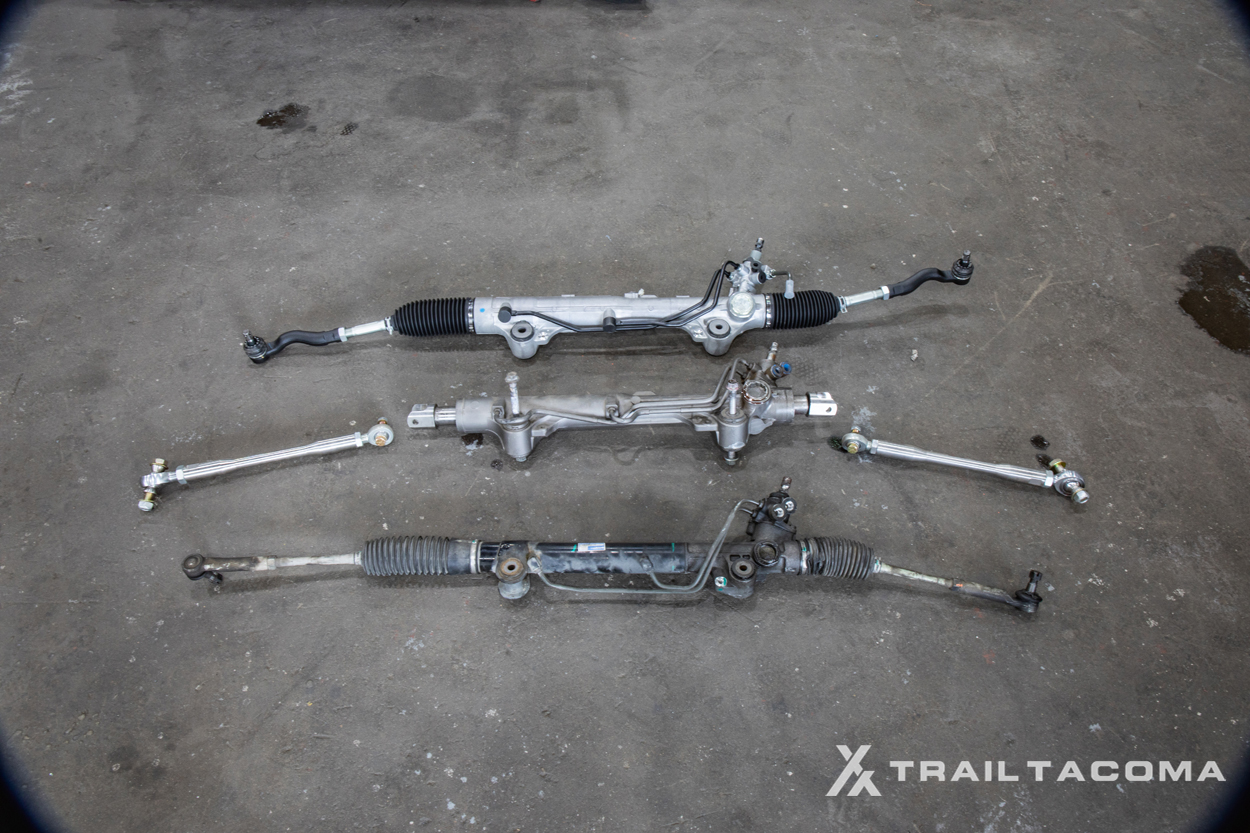
Factory Steering Rack (bottom), Tundra Steering Rack (Middle), Land Cruiser Steering Rack (top)
Most long-travel suspension kits on the market offer a solution for increased strength tie rods and rod ends but not a full steering rack replacement solution.
For most LT kits today, the rod ends being used are known as heim joints or “heims”. The outer rod ends thread onto the tie rod and connects to the knuckle. The inner rod ends thread onto the other end of the tie rod and connects to the steering rack. You can use factory inner rod ends or upgraded heim joints.
Depending on what steering rack you’re running will depend on how that inner rod connects up to a steering rack. If you’re running a factory Toyota steering rack and factory inner rods, just thread your tie rod onto the inner rod end.
If however, you upgrade to a Tundra or 200 series Land Cruiser rack, you will need a steering clevis kit with the correct thread pitch and bolt diameter . For the LC200 rack, you will want a 28mm clevis and for the Tundra, you want a 24mm clevis ( RC Fabrication can sell you both of these). You can, however, use the factory inner rod end that comes on the LC200 rack as the rod end is a good length for the Tacoma and plenty strong enough to turn a 37″ tire. But for the Tundra rack, you need to shorten the inner rod and rack down as the width is too long for the Tacoma. That is why Solo Motorsports makes a modified steering rack specifically made for the Tacoma.
Not many guys want to run the factory steering rack, especially after upgrading all of the other steering components. It’s the path of least resistance to the steering rack after double shear steering, and increased strength rods + rod ends – all while running increased size tires.
With that said, very few long travel kits on the market offer a complete solution all the way down to the steering rack. The Marlin Crawler RCLT kit does come with the “MarRack steering rack” which is an LC200 rack but they provide the pieces that can be challenging to source that connect the steering rack to the column.
Steering Rack (Rack & Pinion) Options:
- Solo Motorsports Modified Tundra Rack
200 Series Land Cruiser Rack Options:
Lowest to the highest price
- Ultra Power 3676N
- A-Premium 369
- AAE AA36N Steering Rack (USA inspected & tested)
- Buy Auto Parts Remanufactured 80-01660R
- Toyota OE Rack & Pinion 80-01660R (this is the steering rack I bought)
Extended-Length CV Axles
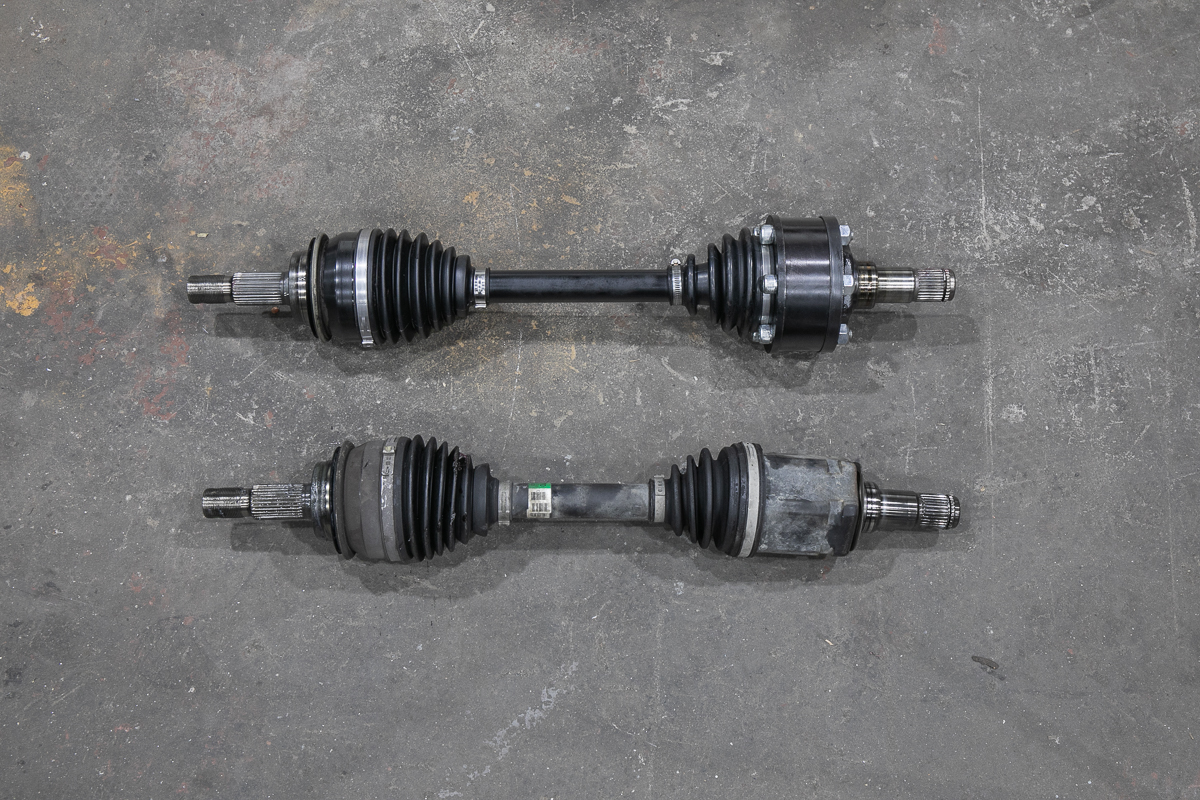
You have a handful of options when it comes to running extended-length CV (constant velocity) axles.
For the most affordable option, you can run upgraded extended-length shafts (usually Chromoly or 300M) and reuse your inner and outer CV joints. This is affordable but it’s also very time-intensive as well. In order to rebuild the inner and outer CV joints , you need the right tools and a bit of patience. It’s not hard at all, just time and energy.
The next option is to buy partially pre-assembled axles and rebuild the outer joints of a CV axle only. This is usually when you want something a bit more custom and you’re either looking for a very specific type of inner joint or you want to save a bit of money by rebuilding your outer CV joints.
The most common option is to go with a company like RCV Axles and/or CVJ axles . These companies offer fully built CV axles designed for your specific width and application. Both of these companies offer great axles but RCV is usually the go-to because they pre-package axles specifically for mainstream kits like Total Chaos, Dirt King, Marlin Crawler, and others. If you have a custom long travel kit, or it’s a new and upcoming company that makes suspension components only, you may need to ask them exactly what CV axle they recommend for that kit and from what company they have tested their kit with.
Different companies offer different joints, too. Most companies offer rebuilt axles with factory-style architecture inner tripod joints and outer ball-style joints, although some offer internal components (4340 and/or 300M) that are much stronger. Some joints are strengthened even more with an upgraded cage as opposed to factory-style housing. For example, companies like JD Fabrication offer a 934 plunging CV axle joint. The 934 offers a full 28 degrees of articulation versus the stock joint sitting 21 degrees. The factory-style joints with upgraded internals are a bit more affordable than the 934-style joints but the 934 is even stronger and provides more articulation. The 934 is a clear winner but it comes at a higher price.
Before going all-in on axles, call these companies, explain your driving habits (fast and hard or slow and abusive) and they will tell you which axle is the best fit for you.
JD Fabrication 934 Axles (stock width, 2-2.5” and 3.5-4”)
- Fully or Partially Assembled with Core Exchange (2005-2015)
- Fully or Partially Assembled with Core Exchange (2016-current)
CV Axle (assembled) Options:
- Axle sets from RCV
- CVJ +2″ 9808 LT2 axle
- CVJ +3″ 9808 LT3 axle
Shaft-Only Options:
- Call RCV and Order Length; +2″, +2.75, +3.5″, etc: (815) 877-7473
- Call CVJ Axles and Order Length: 1-800-292-2953
Inner & Outer Boots
- Inner CV Axle Boot Kit
- Outer CV Axle Boot Kit
Spring Under Vs. Spring Over
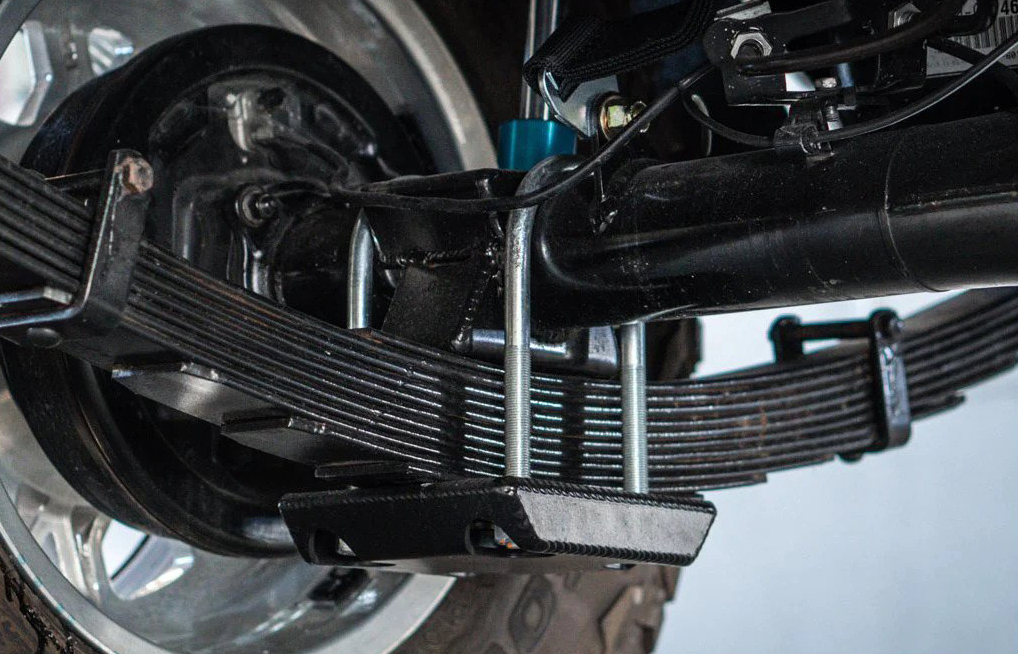
The debate between spring under axle (SUA) and spring over axle (SOA), has long been a controversial topic. Both options have their own unique pros and cons. Before you decide which option you’re going to proceed with on your build, first decide how you’re going to use your build. Are you moving fast through the desert over large whoops where lots of up-travel is needed or crawling slowly over large rocks where good, high clearance and good departure angles are needed?
It’s pretty simple at the end of the day; SUA is typically for fast guys and SOA is for guys who want more clearance – but not always. Again, this topic is one that’s debated hard on many different makes and models.
I’ve listed some bullet points below on a general consensus, however other factors can affect some of these bullets ultimately swaying them to the other side or making them a moot point. For example, some guys will claim SUA boasts better ride quality but ride quality is heavily dependent on spring weight and loaded (wet) bed weight. Can SUA provide a “better” ride quality? Yes, given you have all the other factors dialed in for that specific set-up. Other factors to fine-tune for overall ride quality and performance may include the height/drop of the front/rear shackle hangers, Deaver H70 Vs. H70HD springs, location of shocks, shock stroke, shock valving/tuning, location of perch over/under the axle, hydraulic bumps vs. progressive rubber bumps – along with other factors.
Can you achieve more travel with an SUA kit? Yes.
Does every build running LT in the front need an SUA rear? No.
Spring Over Axle (SOA):
- Better for rock crawling and higher clearance applications
- Provides more ground clearance than SUA
Spring Under Axle (SUA):
- Better suited for desert racing, fast, whoop-focused applications
- Usually provides more travel; specifically more up-travel or “Bump Travel” than SOA
- Lowers ride height
- Minimizes axle wrap
Spring Under Kits:
- Total Chaos Pre/4wd mid-travel (9.5″ travel)
- DMZ Pre/4wd (13″ travel)
- Dirt King Pre/4wd (16-18″ travel)
- JD Fabrication Pre/4wd (17-19″ travel)
- Camburg Pre/4wd (19″ travel)
Questions to Ask Before Buying
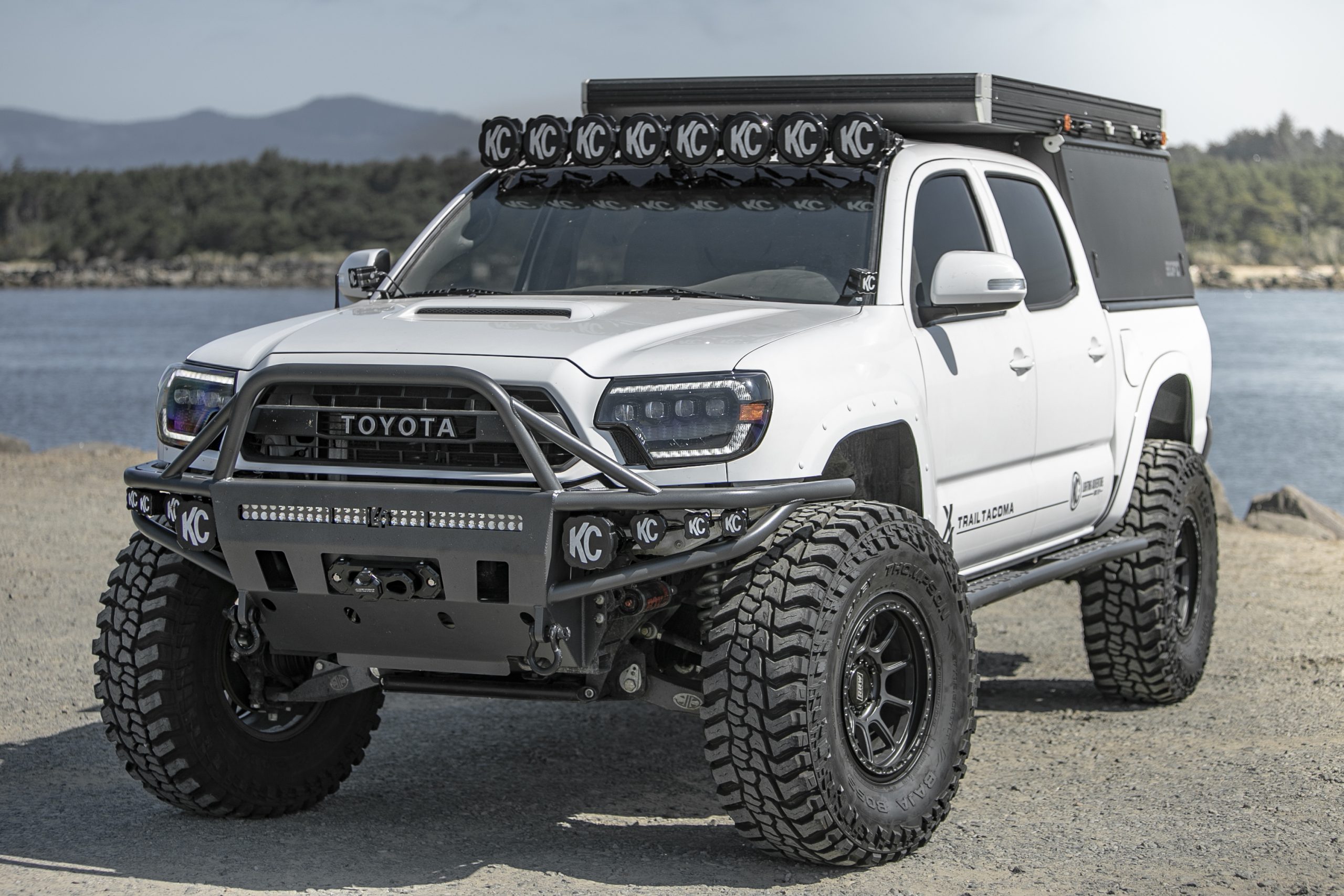
Before you run out and throw your hard-earned cash down on the first long travel kit that catches your eye we have put together a list of questions that everyone should be asking. As with most things in life people tend to gravitate towards the “bigger is always better” motto. Long travel is no different and the assumption tends to lean towards the company with the biggest travel numbers being the best. This couldn’t be further from the truth and the reality is the best product is the sum total of all of its parts/features. With that said here is the list of the top three questions you should be using when evaluating the different long travel kits.
1. How long has the company been in business?
There are a lot of fly-by-night off-road shops throughout the country and only a handful of companies have been around for 20+ years. Having the piece of mind that you are purchasing a kit from a company with a solid track record is invaluable. After all, if things fail or replacement parts are needed you want to know the company will be there to assist you.
2. How long have they manufactured long-travel IFS kits?
If the company has been in business for 20+ years but just started making long travel, you should consider that. Building an off-road IFS kit that can withstand whatever abuse you can throw at it is no small feat and refining the most optimum design can take years. The knowledge and experience a company holds are best gained from years and years of experience building long-travel IFS suspension components.
Most important of all is knowing that the company you purchased your kit from stands behind its product and is willing to assist you whenever you have questions. The older more established companies that have been producing long-travel IFS kits for decades are still in business for a reason and that’s not to be taken lightly.
3. What materials are used for the construction?
All too often this one gets glossed over but it’s important to know what materials these kits are made out of. Is the company using low-cost, low-strength mild steel or super strong, high-grade 4130 Chromoly? The strength difference between the two is dramatic and knowing what’s under that fancy powder coating is not to be overlooked!
4. What materials are used for the suspension pivots?
Is the company using poly bushings that become noisy and wear prematurely? Are they using harder Delrin bushings instead of poly? Did they do away with bushings altogether in favor of uniballs? How about sealed uniballs?
While the cost of uniball pivot arms has a greater upfront cost the performance and reduction of maintenance far outweigh the cost. Even better would be a sealed uniball design that will never squeak (like poly bushings) while remaining completely sealed from the elements. After all, the last thing you want is to drop a bunch of cash on a kit that is constantly needing maintenance to keep it from squeaking and rattling.
1. Total Chaos (+2″ and +3.5″)
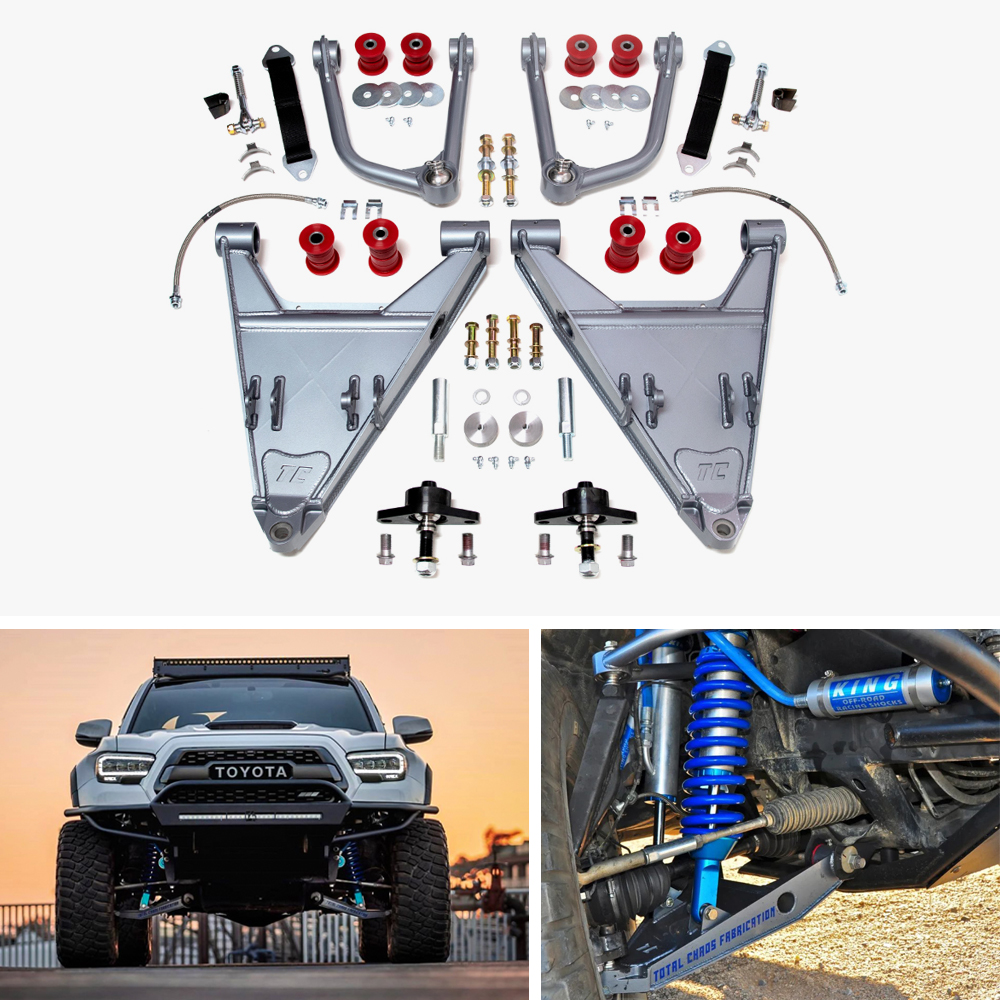
Total Chaos has long been the leader of the LT segment for decades when it comes to LT Toyota applications. They offer everything from beginner kits to extremely advanced kits and for many makes and models. They are well known for their wide variety of sizes. They offer parts for both the front and rear of your Tacoma and if they don’t have a full plug-and-play option for the rear – they work with just about every company out there so they can recommend a comparable rear setup for whatever front you decide to purchase.
Kit Offerings
Total Chaos leads the race offering 4 total kits; multiple +2″ and +3.5″ kits. The +2″ expedition kit offers 2″ more ground clearance than the +2″ standard series kit. In the +3.5″ class, they offer two kits; the standard series & race series. The race series +3.5″ kit provides 2.5″ more ground clearance and is 5 pounds lighter per lower arm than the standard series +3.5″ kit. You can get any of these kits with bushing or heim pivots at the UCAs.
- +2″ Standard Series
- +2″ Expedition Series
- +3.5″ Standard Series
- +3.5″ Race Series
Find it online:
- +2″ Standard Series Kit
- +2″ Expedition Series Kit
- +3.5″ Standard Series Kit
- +3.5″ Race Series Kit
2016-Current
Trail Takeaway
Total Chaos starts at around $3100 and goes up from there. If you’re looking at the 2″ class, you might as well opt for their +2″ Expedition Series at $3600 as it gives you another 2″ of ground clearance over their standard kit. The same applies to their +3.5 Race Series kit. It’s only another $500 for less weight and more ground clearance.
The downside of Total Chaos is that they use poly bushings and not sealed uniballs or even open uniballs for the pivots. Also, the TC lowers are boxed and do not feature a slant for sliding over obstacles which you should consider if you like the rocks. Finally, you can buy the axle shafts on Total Chaos but you will need to assemble your inner and outer joints. They do not offer fully built axles at this time.
2. Camburg (+2″ and +3.5″)
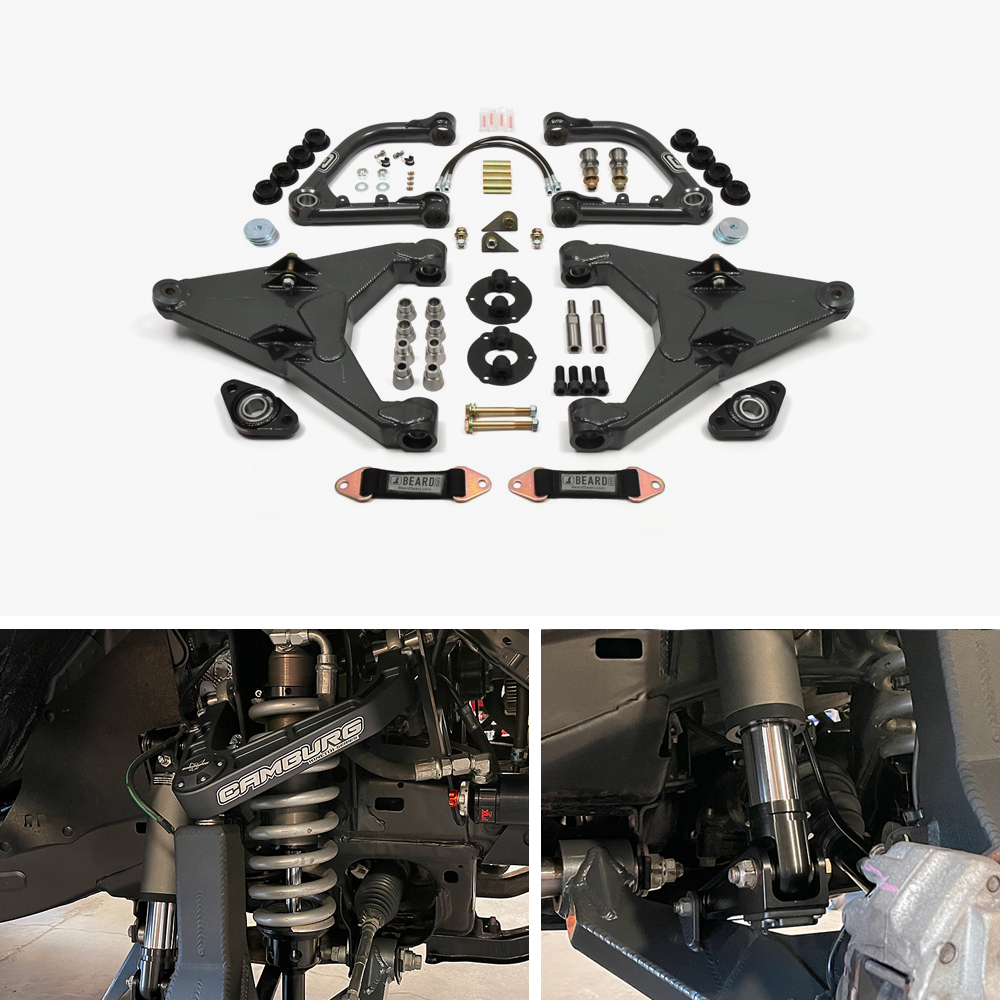
Camburg is a race truck company at the core and they have been for over two decades. They build chassis, and axle housings for trophy trucks from the ground up and provide some of the most dependable parts for quite a few Ultra4 class builds. Camburg isn’t just moving the needle when it comes to quality fabrication, they also bring insane ingenuity to the table. They just released their new “slapper arm” kit which is a hydraulic bump stop connected to a lower control arm via a link. Simply put, it’s designed to vastly improve bottom-out control. If you like FOX shocks, you’re right at home with Camburg. They pair just about everything they build with FOX, however, Kings work as well.
Camburg currently offers two kits; a trail series +2″ kit with the slapper arm bump stops and a race series 3.5″ kit which can also be optioned with the slapper arm bumps. Both are available with bushing or heim pivots at the UCAs. You can add extended-length axle shafts, however, they do not come assembled. You will need to reassemble your outer and inner joints once the shafts come. For spindles, Camburg doesn’t offer a spindle gusset kit, however, they offer their fabricated performance spindle kit which works with their LT kit. If you want to option secondary bypass shocks, you need to call or order them separately. Also, if you want double-shear steering and outer/inner rod ends – you need to call.
Find it Online:
- Race Series Kit
- Rear Spring Under Kit
Camburg sells a bunch of parts for the rear as well; HD Deaver springs, a pre-fabricated bed cage, leaf perches, and a spring under kit. This company is the real deal when it comes to LT as they have been in the game for decades. The only challenge I see with the Camburg lower arms is that they sit lower than other arms due to their lower ball joint adapter kit on the LCAs. If rock crawling is important, this might be a kit you want to avoid as you will lose clearance here.
3. Dirt King (+3.5″)
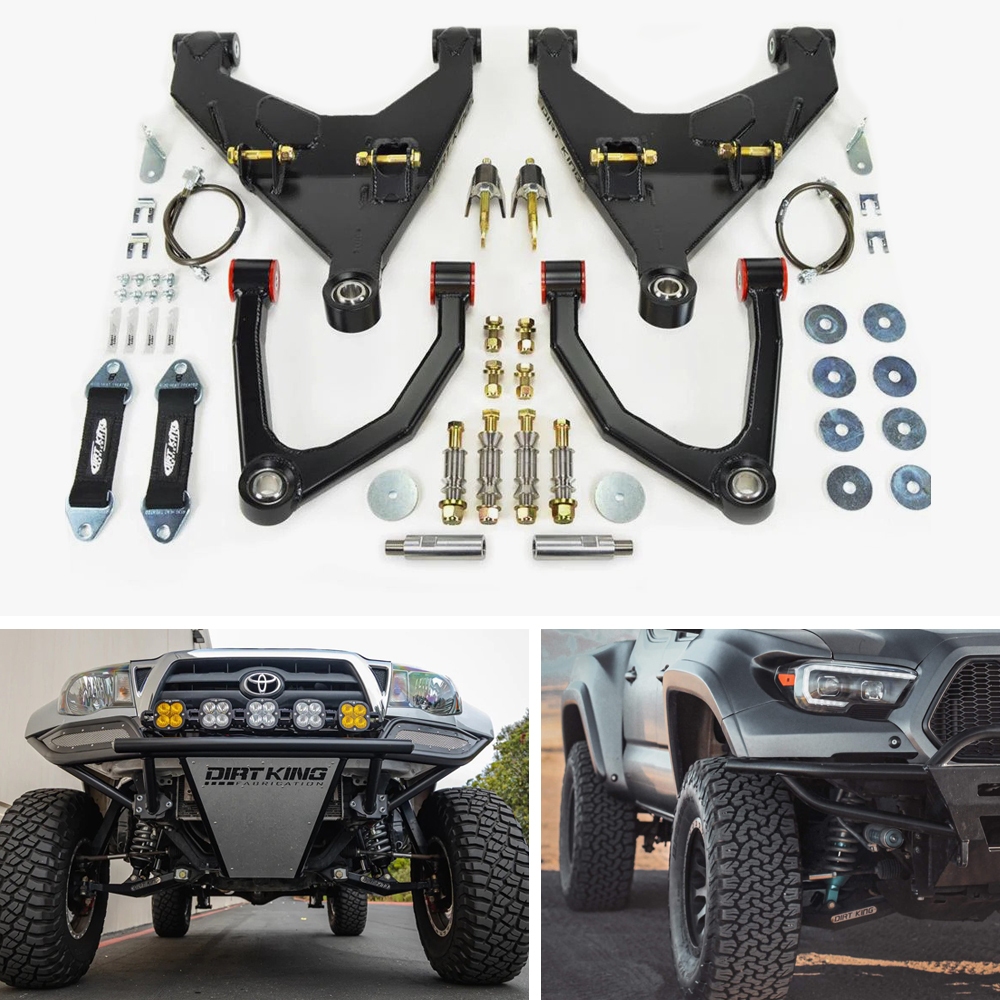
Dirk King is relatively new to the long travel scene with roots back to 2011. DK got its start with Prerunner style front bumpers and custom fabrication services – with a focus on the Titan market. Then they finally entered the Toyota market with their boxed upper control arms in 2014, and then finally LT kits sometime around 2015-2016. Although Dirk King is relatively new to the scene, they have quickly become an industry leader. Right up there with Camburg and Total Chaos, Dirt King is quickly gaining market share with their high-quality kits and full-service product offering. I really like what Dirt King has to offer for LT.
They offer the +3.5″ race kit at this time boasting an impressive 13.5″ of wheel travel with the option of bushing or heim pivots at the UCAs. Their lower control arm features an aggressive slant on the forward face instead of a boxed design which will help clear obstacles in the rocks. Another notable selling point is that they use Derlin bushings, not poly bushings like TC. Finally, the DK lowers feature built-in forward positioning of about 1/2″ which pushes your wheel forward which is a plus for wheel placement for larger tires.
- +3.5″ Dirt King Kit
- Dirt King Axle Assemblies
- Dirt King Spring Under Kit
DK offers many secondary components that complement the kit both front and rear. To start, they sell fully assembled axles with the inner and outer CV joints assembled on LT shafts – shipped to your door. Not many companies other than JD Fabrication offer fully-built LT CV axles. This is a huge upsell for some who don’t want to pull apart inner and outer CV joints.
Dirt King also offers a spring under kit for the rear, a prefabricated bed cage designed for 16″ shocks, and the H70 HD Deaver springs you need for the rear. They also sell all the compatible coilovers, triple bypasses, and rear shocks for an LT kit. Dirt King carries and sells literally every part you need for a full plug-and-play LT kit for the 2nd and 3rd Gen Tacoma.
4. JD Fabrication (+2.25″ and +4″)
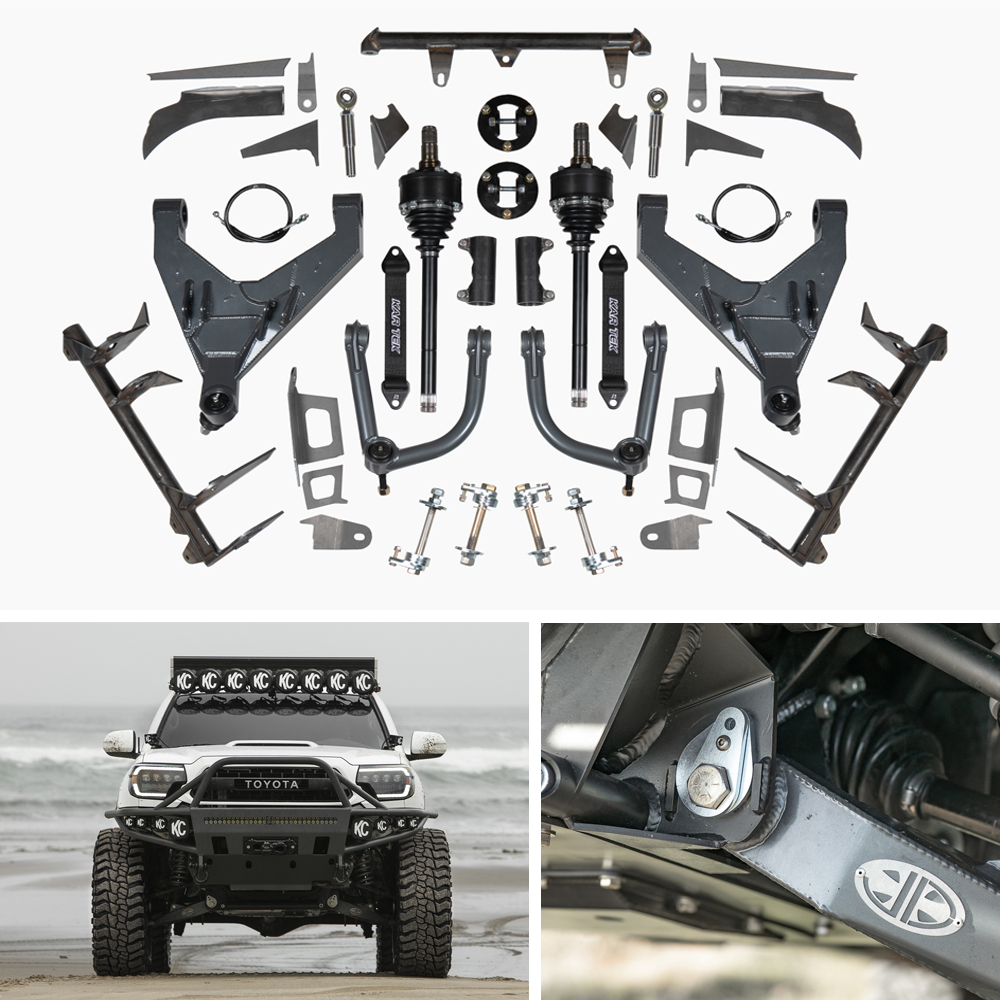
JD Fabrication builds desert race trucks and fabricates some pretty interesting parts that no other company makes. Their team has built long travel suspensions for well over 20+ years. These guys offer every solution the industry wants for LT, but be prepared to pay. Let’s start with their LCA pivot kit. This is the answer for larger tires. This kit removes the factory LCA mounting points and welds in a wider replacement with adjustable cams which push the lower control arm up to 1″ forward. That’s not pushing the caster (measured in degrees) forward, that’s pushing the center point of where your wheel mounts to the LCA.
This will clear a 33″ tire without any modification at all, a 35″ tire with minimal modification, and a 37″ with mild modifications (pictured above). JD Fabrication also offers one of the strongest CV axle joints on the market; the 934 Chromoly caged plunging CV joint with 300m axle shafts.
Additionally, they offer a set of inner fender replacements, a steering rack “slide rack” reinforcement, and all the other bells and whistles that most mainstream companies are producing; LT bypass shock hoops, double shear steering upgrade, Chromoly tie rods, spindle gussets, steering pump upgrades, spring under kits, and more.
They offer +2.25″ and +4″ length kits with just about everything you need to go along with them. We wrote a full overview blog post on their 2.25″ long travel kit and then another step-by-step installation guide as well. If you want to read more about the JD Fabrication offering, check out those posts for more on their kit offerings.
2nd Gen Tacoma (2005-2015)
- 2005-2015 Lower Arm Pivots $100 Off (Coupon code “trailtaco”)
- 2.25″ Long Travel Kit
- Front Skid Plate
- 934 CV Axle Upgrade Kit
3rd Gen Tacoma (2016-Current)
- 2016-Current Lower Arm Pivots $100 Off (Coupon code “trailtaco”)
Trail Takeaway
You can buy everything you need from JD Fabrication. One really important detail about JD Fabrication is that they do not use heims on their UCAs as heims that are exposed to the elements don’t hold up through extreme weather conditions. Instead, they have machined upper and lower uniball inner pivots that accept seals and are 100% weatherproof. At the time of writing, no one else offers sealed uniballs where the uppers and lowers pivot. Additionally, they use very high-quality sealed EMF uniballs for the outer pivots. This is a dependable LT kit for those that live in an area where harsh weather is consistent, or you drive on the beach with salt water, among many other scenarios.
All of their kits are constructed out of 1/8″ and 3/16” Chromoly with extensive internal ribbing. They also incorporate an integrated CV “pocket” built into the LCA so the arms can achieve more ground clearance. Finally, JD Fab kits will work with the OE style king and Fox shocks.
This is the kit we choose to run on our 2G Tacoma for a reason. It stands out from all the other companies on the market for our intended use; heavy rock crawling with trips to the beach and go-fast moments here and there. This kit really does it all – which is why I wrote this post.
5. LSK (+4.5″)

LSK makes a couple of monster long travel kits; a race kit for 2wd Tacomas pushing almost 16″ of travel, a spindle bolt-on kit for 2wd trucks pushing 14″ of travel, and a kit for 4wd rigs also pushing 14″ of wheel travel. All kits are +4.5″ wider on each side and come with the LSK signature heim pivot UCAs. And, instead of uniballs or ball joints connecting at the spindle, they feature heims boasting a full range of articulation where your only limit is how you set your limit straps and build your fender wells.
LSK is very different from every other kit on the market due to its unique a-arms, heim pivots, cam lockout plates, and supplied pre-built spindles. They also provide everything else you need for your kit; rod ends that connect double shear at their spindles, DOT extended brake lines, secondary shock hoops, the necessary shocks, and all the hardware you need to link it all together.
Even though they call their kits “bolt-on” there are still some areas that need to be welded so don’t let the product titles fool you. All in all though, if you’re going with a +4.5″ LT kit, you’re not worried about a little welding.
LSK does provide extended-length RCV axle shafts, however, you’re responsible for rebuilding the outer and inner joints when the shaft arrives. If you want prebuilt axles, just order +4.5″ LT axles direct from RCV – booted and all.
This is the kit you buy if you want to go extremely fast, maybe swap in a 2JZ, LS, or something insane that warrants some serious race travel.
6. Marlin Crawler RCLT (+2.75″ and +3.5″)
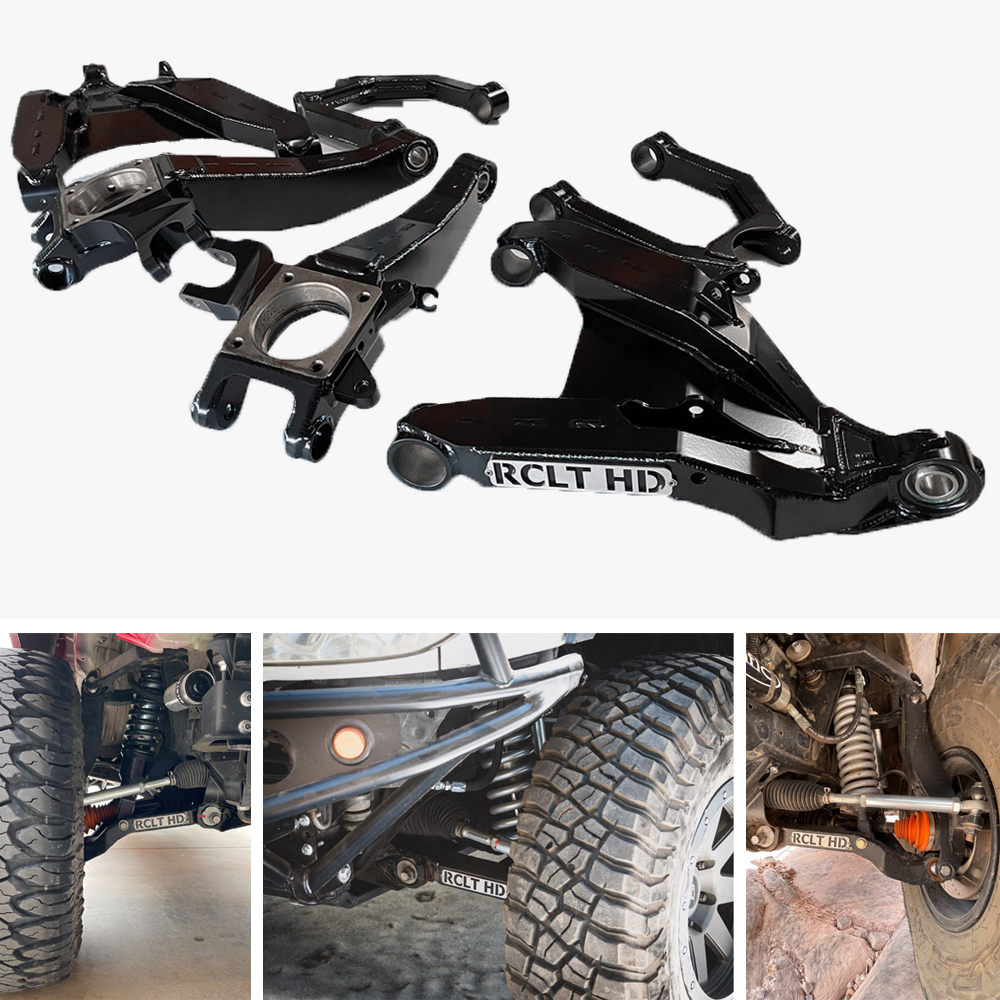
The leader in everything offroad is Marlin Crawler. They have led the race in aftermarket part fabrication for decades and their RCLT kit is no exception. It’s by far one of the most advanced long travel systems specifically designed for rock crawling, hence the name “Rock Crawling Long Travel” .
This is Marlin Crawler’s first venture into the IFS world and offers two options for the new LT kit; the +2.75″ and the +3.5″ version both pushing 12.5″ of wheel travel measured at the hub and 14.5″ at the centerline. The kit comes with horizontal ball joint linked at the spindle and bushing pivot UCAs, CAD design pre-fabricated knuckles/spindles with double shear steering points for their MarRack (200 Series Land Cruiser Rack), 1/4″ mild steel boxed lower control arms with horizontal ball joints, and finally, the kit uses FK uniball bearings and tie rod ends. The kit’s knuckles are pushed forward +2″ over the factory increasing both forward wheel positioning and approach angle.
Marlin Crawler has a few configurable options for this kit but it really breaks down into their “ Standard Installation ” which runs you about $9000 and their “ Ultimate Installation ” which sets you back almost $12,000. That’s with everything you need out the door; LT kit, shocks, axles, and steering rack.
The LT kit alone is around $7500.00. Then you have to pay for your shocks (coilovers and optional bypasses), the 200 Series Land Cruiser steering rack, and CV axles. This is a great LT option if you’re solely looking to dominate the rocks.
This kit is designed for the person that really wants this kit. Marlin Crawler has done a great job of selling this kit as the “premier option” and “leader” in rock crawling IFS, however, there are other kits that compete. Just because the slowest Tacoma on IG (owner of Marlin Crawler) is running 40s with this kit doesn’t mean you should or can. That Tacoma is also running dual cases (Marlin Crawler Taco Box) which helps to reduce the stress on many other parts and maintain control when wheeling at low and high torque. Running a reduction box is very important if you’re considering IFS on 40s for many reasons. These RCLT parts are impressive, yes. However, they do oversell some points on tire size and don’t tell the whole story of what really needs to be done to run 40s.
7. Baja Kits (+2″)
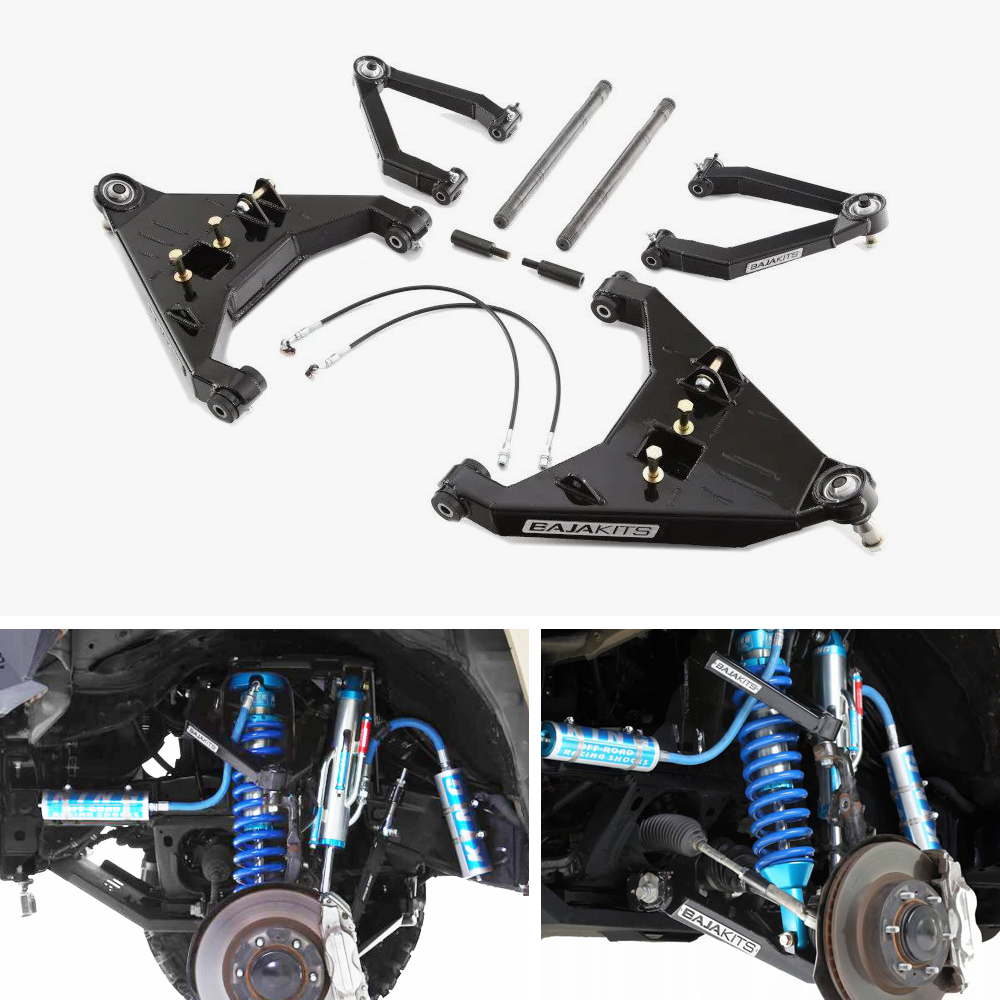
Baja Kits offers a +2″ kit pushing 11″ of travel. This kit is about as straightforward as it gets when it comes to long travel; boxed upper and lower A-arms, Delrin bushings pivot the UCAs/LCAs, uniballs, extended brake lines, and all the hardware you need to install. Baja Kits does show a photo of their “heat-treated axle shafts” that comes with the kit, however, they do not quote whether or not it’s Chromoly or 300M. We also don’t know if they use mild steel or Chromoly for the construction of the arms. At this time, no options are configurable for assembled axles, limit straps, cans/brackets for hydro bumps, spindle gussets, and/or UCA double shear gussets (although they do sell these separately), hoops for bypasses, and nothing in the steering department either. They do, however, sell King coilovers and bypasses.
The kit does not come with options for what most would consider “must-haves” when building a long-travel suspension so if you want a fully built-out LT kit with all the bells and whistles, you might want to look elsewhere.
All in all, you know the quality is there with Baja Kits because of their parent company. Brenthel Industries (a race truck build, design, and engineering company), builds and manufactures all their uppers and lowers.
8. All-Pro Off-Road (+2″)

The All-Pro Offroad kit is a +2″ kit boasting 12″ of wheel travel and 2″ of ground clearance. All-Pro Offroad actually offers a pretty robust kit for the money. For a similar price to what most kits sell just uppers and lowers for, All-Pro Offroad includes the majority of parts you need. In this +2″ long travel kit you will find tubular-style Chromoly UCAs and LCAs, limit straps with brackets, DOT brake lines, spindle gussets, rod end extensions, along with the inner and outer CV boot kit. The only items you won’t find included in the kit are shocks, bump stops and axle shafts. And, if you want secondary shocks, you will need to source the hoops and bypasses separately.
For around $3200, it’s actually a pretty good deal for a +2 kit. The uppers and lower are not boxed, but they are Chromoly so you know they’re plenty strong. The fact that it’s being manufactured and sold by All-Pro Off-Road should give you plenty of peace of mind going into the purchase.
These kits has been around for quite a while now. If you’ve been watching All-Pro recently, they’ve been slowly giving sneak peaks of their completely redesigned system. A system that is supposed to be a superior, direct competitor for the RCLT HD kit. More to come soon!
Find It Online
- 2005-2015 All-Pro Long Travel Kit
- 2016-2023 All-Pro Long Travel Kit
Final Thoughts
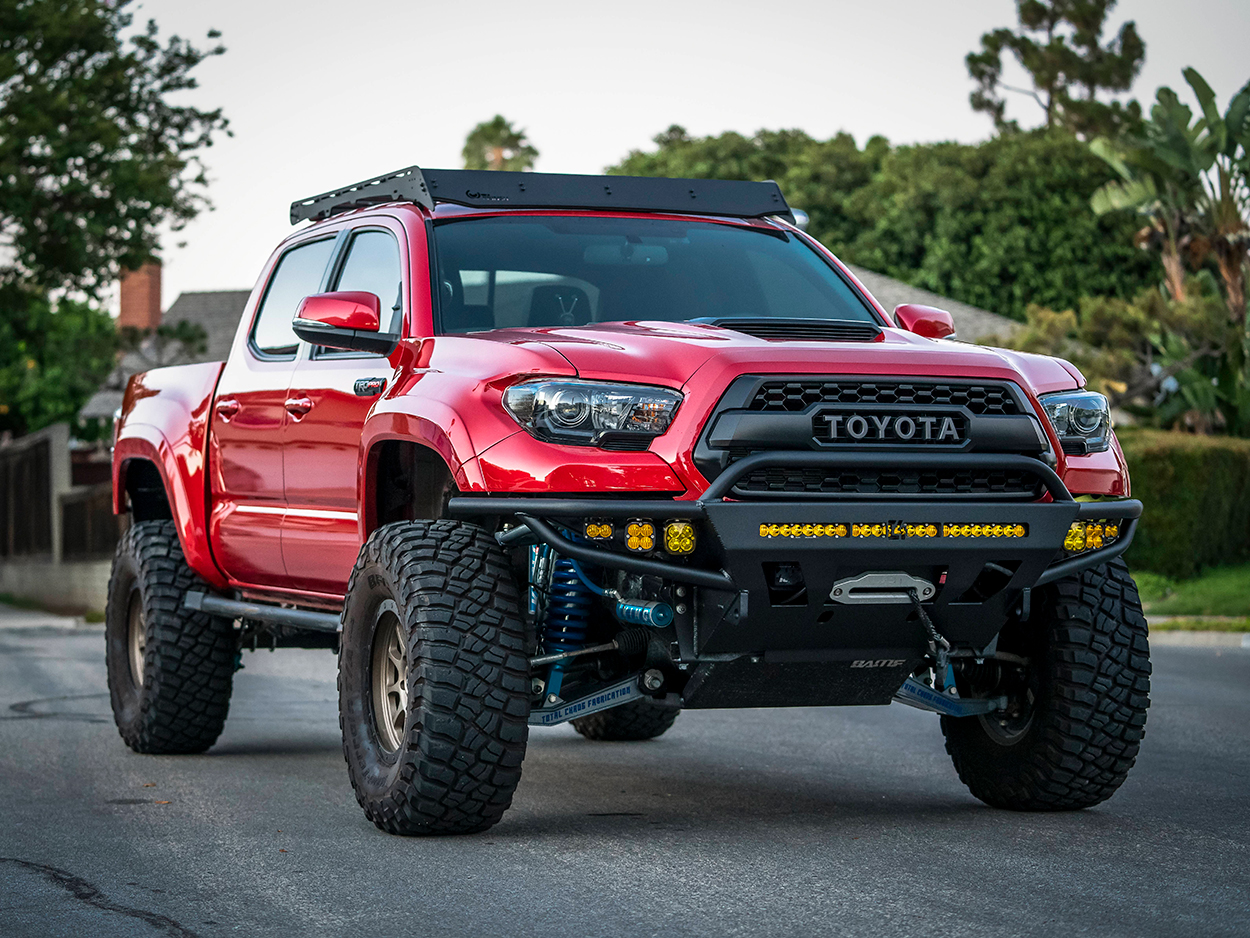
There is an LT option out there for everyone, however, the two most robust offerings on the market are from JD Fabrication and Marlin Crawler. Both companies offer the complete package and a quality solution for Toyota IFS.
JD Fabrication
We decided on the JD Fabrication 2.25″ kit for our Gen 2.5 Tacoma previously pictured above. JD Fab offers selling points that no other company offers, mainly found in their LCA pivot kit. The LCA pivots allow for larger tires without extensive cutting and/or tubbing of the firewall, depending on tire size. If you want to maximize tire clearance around the firewall, keep your Tacoma aligned to factory spec with the arms in the center of the adjustment range, and eliminate side load on pivot bushings all without sacrificing on-road driver comfort, then this is a kit to consider. They also paid very specific attention to ensuring that every pivot point on the suspension is fully sealed making the kit ideal for those that live in harsh climates.
This kit offers the best combination of “go fast” strength while still maintaining insane ground clearance in the rocks thanks to the integrated CV pocket. JD Fabrication has been building long travel suspensions for over two decades and on paper, their new LCA pivot kit challenges almost everything we know about Toyota IFS. The cool part about the LCA pivot kit is the pivot opening is the same as the factory which means you can run any lower arms that fit the factory all while pushing the tires forward upwards of 1″. Your options are endless with JD Fab, you can piece your own LT kit together or you can stay within the JD Fab ecosystem of products and also end up with a very custom setup.
Marlin Crawler
The Marlin Crawler 2.75″ RCLT sits at the top as another IFS LT contender and some will argue that it’s the best rock-focused LT kit out there, however, some have debated that point and the quoted travel numbers. That said, it’s made by Marlin Crawler who’s been a staple brand in the off-road community for decades so you know you can trust their quality which is why I think it’s a great option. The kit does feature quality selling points like a fully fabricated spindle and horizontal uniball pivots. These are nice, but a fully fabricated spindle doesn’t guarantee more up-and-down travel based on articulation range alone. Wheel travel is also limited by the inner fender well, fenders, bump stops/mounts, among other limiting factors.
RCLT quotes the kit as compatible with a 40″ tire as that is the tire size warranty limit of RCV axles, and the arms do push the tires forward upwards of 2″, however, a lot of work goes into running 40″ tires on Toyota IFS. You can expect more work than just upgrading your steering rack, CV axles, and connecting double shear points on the spindles. Also, keep in mind that the MarRack is simply a Land Cruiser 200 series rack. We installed one on our 2nd Gen Tacoma almost a year ago so it can be done on your own with any other kit, given you have the know-how. The benefit of buying a kit from Marlin Crawler is that you get their install kit for the rack which includes a jig and all the secondary hardware needed to connect the shaft. On the landing page of bullet points and benefits , Marlin Crawler sells the kit well, however, you need to source many extra parts on top of their kit. At the end of the day, you don’t have that many options with this kit. They offer two options and they’re both very expensive.
Other Options
LSK, like Marlin, also offers a very comprehensive kit with their fabricated spindle, although there is very little information online about their testing and performance.
If you’re looking for a bolt-on kit, Camburg, Dirt King, All-Pro Off-Road, and Total Chaos offer great entry-level to advanced options. These companies all offer straight bolt-on options along with add-ons that require fabrication as well. You can expect fabrication work anytime you add additional parts like secondary shocks, hydro bumps, and limit straps, among other items.
Within each of the company offerings, most differences come down to LCA and UCA design. Reference that section on this post again, and you’ll understand how important every aspect of the LCA and UCA design is when purchasing a kit.
It’s hard to choose one kit on this page as the “best” as there is no best in this industry, only the best for how you intend on using your truck.
Brenan Greene
Brenan is the founder of Trail4R.com, Toyota guy through and through, verified nature lover, lightweight photographer, exploration enthusiast, and certified serial blogger.
People incorrectly assume that tire width affects traction and it is actually the longitudinal section where the tire is in contact with the ground. The way to increase this contact area is with a taller tire and not a wider tire. Wide tires are good for floating over snow and sand but those are special case situations. Wide tires that extend past the sides of the truck are a good way to toss rocks up against your truck and any vehicle or person in your vicinity.
Great article… I’ve got a TC Race 2” on my 5th gen 4runner. I love the functionality but after fighting the poly bushings for years I’m ready to find a new system if I can’t find a lasting solution to their noise. They’re way too noisy! Any suggestions on managing the noise of poly bushings? (Other than lube and maintenance) If not, I’m ready to move on. Thanks!
Very very informative article, I currently have a stage 1 mid travel kit on my 3rd gen mostly used for overlanding and camping, but have been looking to upgrade to a “go-fast” LT set up and couldn’t have found a better article. Thank you lots I will rely heavily on your info as I still consider myself new to the OR community.
Great read !!
Awesome, glad you enjoyed it. Only took me 2-3 months to write. haha
Only question I have is how much of my current set up can I salvage or does it all have to b changed for a LT coming from the Mid Travel
It depends on the setup you’re running but for most kits you replace everything. You can always keep your factory spindles, steering rack along with inner and outer CV joints, but everything else is longer and wider. Those parts include coilovers, tie-rods, CV shafts, LCAs, UCAs, in addition to all the other parts and pieces you need. Things like limit straps, optional cam tab gussets, and optional double shear components if you choose to go that route.
i thought so, well seems my 2.5 kings are going on my dads 2nd gen lol thanks for the response and info
Going down the road of long travel for my 3rd gen Tacoma right now and this is by far the most helpful information online. Thanks for this.
Awesome, let me know if you have any questions.
correct me if I’m wrong, but if this adds some width to the front then what do you do to the back, like would you have to use spacers or offset wheels only in the back?
Yeah, you’re right. On our JD FAB 2.25” LT we’re running 1.25” spacers in the rear to match the front.
no mention of the Solo Motorsports XLT kit which is +4.5″ and offers 19″ of useable travel with 4wd
Yeah Solo makes some killer stuff. I’ll work on getting them integrated into this post when I have some free time. Thanks for the heads up.
Great writeup! I can’t wait to get my Total Chaos kit on my truck!
This is probably one of the most informative articles that truly adds value to the conversation of LT for Toyota.
Talk about a walk through of all of the pros and cons! LT is a very in depth subject for any vehicle, it’s nice to see a thorough dissection of the products available and why one might be better for someone over another. Bravo! I would like to see a little more general information on the maintenance that can be expected with an LT equipped truck, because there is a lot more than a stock setup 🙂

DUDE. Wow. I’ve spent a lot of time over the years doing quite a bit of research to really understand how to build my truck. Resources that go this deep are few and far between. This is definitely one you need to bookmark. This an essential post on all things long travel. I learned quite a bit too! Also, having driven your 2G, the JD Fabrication really is next level. That pivot kit is a game changer.
This was super informative, I didn’t realize that true LT started at 2″ always thought it was 3-4″+). TONS of considerations it seems if you want to do LT the right way and this is an excellent resource to get started ??
GET 20% OFF
Take up to 20% off at the 4runner store.

Off Road Suspension: Stock Width, Mid-Travel, and Long Travel Explained
- October 26, 2022
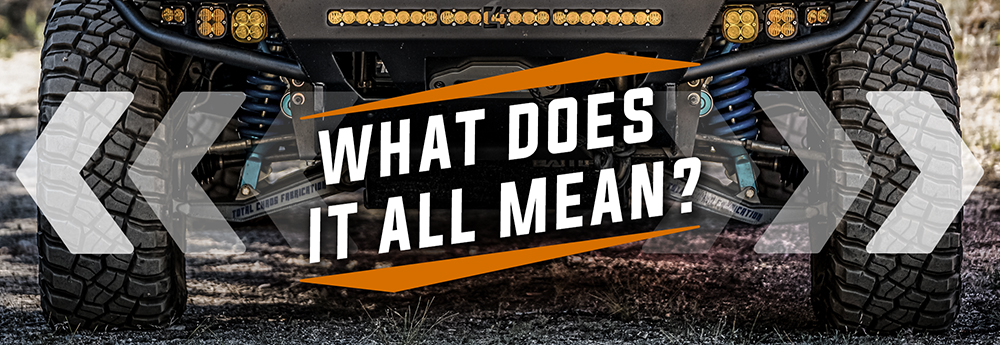
In the off-road world suspension terms like stock width, mid-travel, and long travel are thrown around without explanation. But what do they mean and how do they affect vehicle handling? In this article we will take a quick look at a few of our different truck & SUV suspension lift upgrades and explain how much lift and wheel travel you can expect to gain from the different systems that we offer.
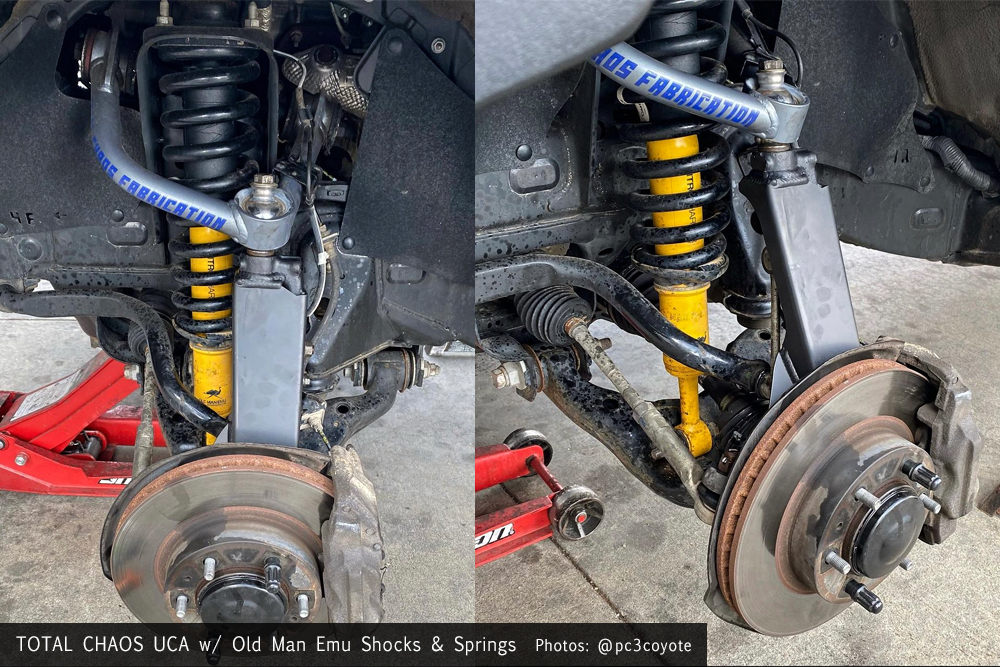
STOCK WIDTH SUSPENSION
Entry level stock width suspension systems replace the OEM components without changing any of the factory geometry. Track width, or how wide the vehicle is from hub to hub, remains the same as it was from the factory. Stock width setups consist of basic shock & spring lift kit such as Bilstein 5100 , Old Man Emu , or Dobinsons . With these configurations the front end is lifted anywhere from 1”-3” and you’ll have the same amount of travel as the stock vehicle. The down side to these is often times a stiffer, more harsh ride. When you lift it closer to 3” you’re maxing out the stock ball joint angle and accelerating wear.
It is important to upgrade upper control arms even on the more entry level lift kits. When you lift a vehicle you lose caster in the front end which negatively affects handling. TC stock width upper control arms are designed to add a few degrees of caster back into the front end which helps improve steering feel and makes alignment easier. The 1″ stainless steel uniball is tougher and offers greater articulation over a ball joint. If the basic stock width setup isn’t quite enough, upgrading to a mid-travel system might be necessary.
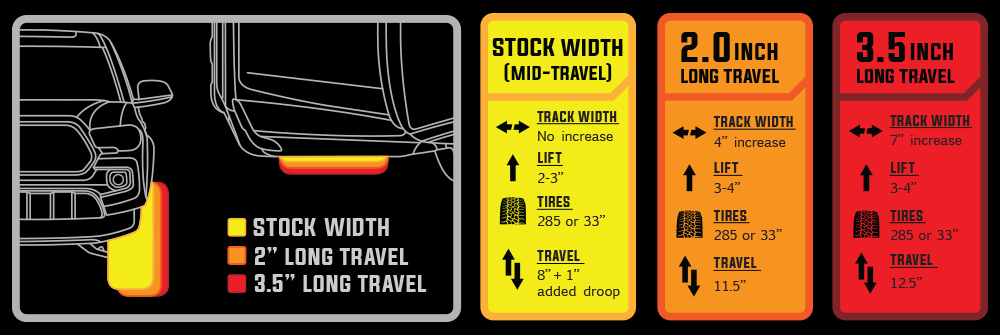
MID-TRAVEL SUSPENSION
Performance mid-travel setups consist of stock width uniball upper and lower control arms paired with with extended travel adjustable coilovers from manufacturers like King , Fox , and Radflo . These extended travel coilovers are designed to maximize wheel travel without binding the inner CV’s and outer tie-rods. With an adjustable threaded shock body, they provide anywhere from 1” to 3” of vehicle lift and cycle 8” of wheel travel plus an additional 1” of droop or down travel.
Vehicle track width will remain the same as stock since the upper and lower control arms are stock width. A mid-travel setup can be extremely effective on the trails. Ride quality is enhanced along with the occupant’s comfort and trail driving fatigue is reduced. The benefit of installing a TC mid-travel setup is significant performance gains and added component durability without having to worry about installing fiberglass fenders. Stock length UCA kits are designed not to be too wide for tighter trails in dense wooded areas often found on the east coast or in the PNW.
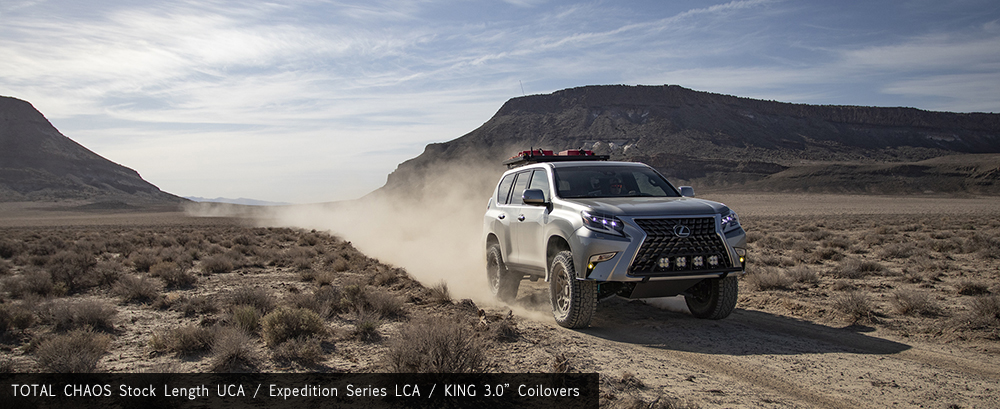
To maximize your mid-travel set up you can install a 3.0” coilover or add a secondary bypass shock with compression and rebound adjustment tubes for maximum dampening control and tunability. To add a secondary shock up front you will need a shock hoop and a lower control arm that is tabbed for a dual shock suspension system. From our experience, upgrading to DuroBump bump stops can further enhance the ride quality and reduce the harsh bottom outs.
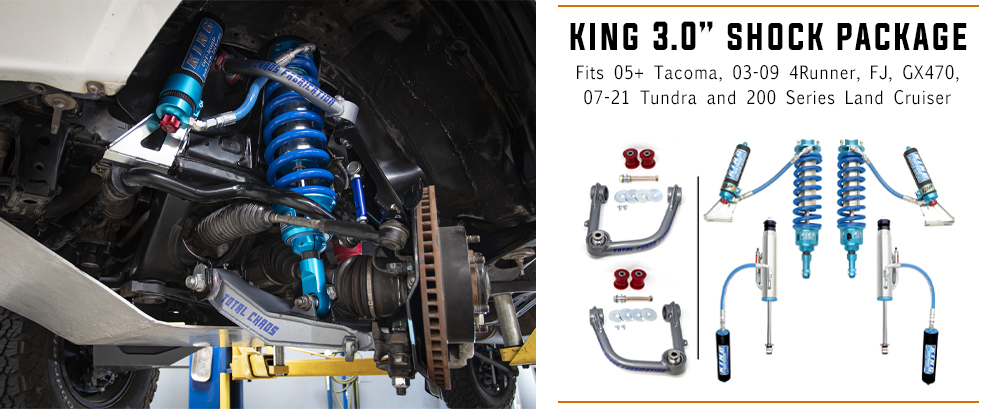
LONG TRAVEL SUSPENSION
Still looking for more performance? A long travel kit might be in your future. Long travel suspension includes upper and lower control arms that are wider than your stock components. These high performance IFS suspension systems are designed to increase the amount of wheel travel that you cycle and ensure that you maintain traction on rougher terrain. Because they are wider than stock, long travel suspension kits offer more articulation when crawling over obstacles and will add stability when cornering at high speed.
TOTAL CHAOS offers long travel kits for most Toyotas from 1986 to present including Tacoma, 4Runner, FJ Cruiser, Tundra, Lexus GX470, and GX460. Our most popular long travel systems are the +2” Expedition Series or +3.5” Race Series. With extended upper and lower control arms you’ll be adding 4″ or 7″ respectively to the overall track width of the vehicle. Both Expedition and Race Series kits offer 3″-4″ of vehicle lift with adjustable long travel specific coilovers. +2″ Expedition Series kits will cycle about 11.5″ of wheel travel while the wider +3.5″ Race Series will cycle about 12.5″.
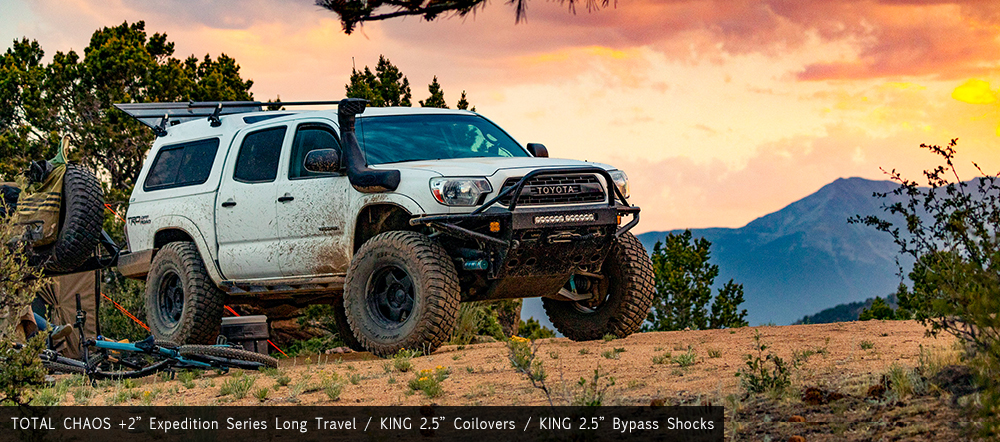
TC custom long travel shocks are built by each manufacturer to specifically cycle the correct extended and collapsed lengths based on each long travel system and its factory bump stop configuration. Stock width extended travel shocks do not work with a long travel kit. All TC lower control arms are manufactured with dual shock capability for maximum dampening control to tune your vehicle for harsh bottom outs or added aftermarket equipment weight.
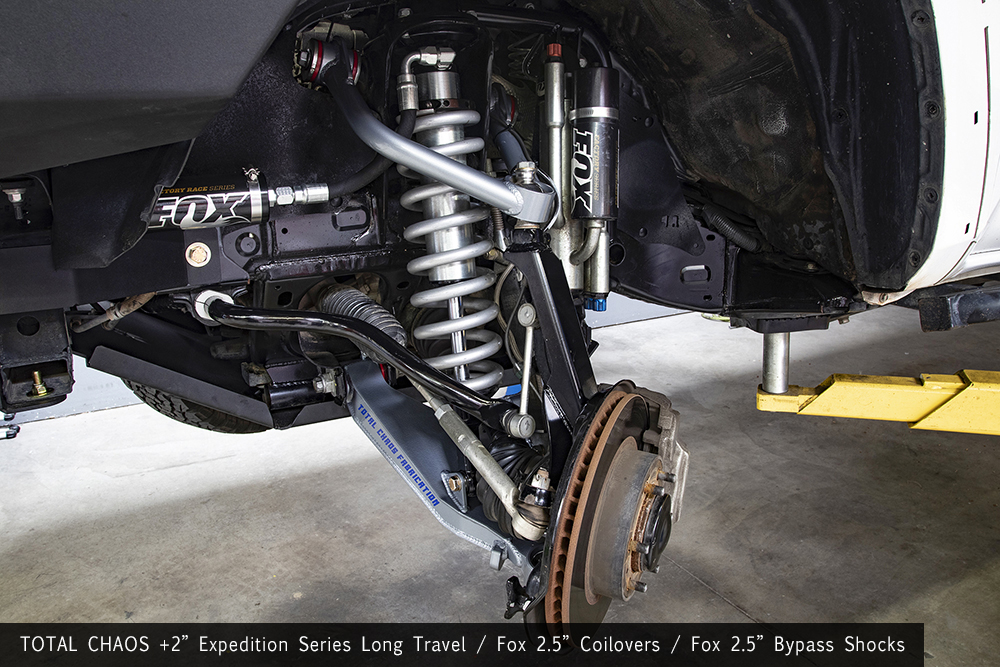
Extended control arms will require you to increase the length of many of the other parts that are now too short. Additional items that are part of the package include extended tie-rods and extended brake lines. Extended axles will also be required when retaining 4WD (sold separately) and are re-inserted into the factory inner and outer CV’s. Each vehicle platform has wheel travel limitations in the factory steering system and axle assembly and we design our parts to work within the parameters needed to retain many factory Toyota components. Based on our 25 years of experience they last the longest.
Whether it is a stock length, mid-travel, or long travel suspension setup the most important thing is hitting the trail and sharing good times with your friends and family. Learning the capabilities of your rig at all modification levels is important and helps you to appreciate each upgrade you make. More importantly you will build your skill as a driver. Get out there and cause CHAOS. We will see you in the DIRT!
MID-TRAVEL GALLERY (CLICK TO EXPAND)
+2" expedition series long travel gallery (click to expand), +3.5" race series long travel gallery (click to expand), 2007-2021 tundra long travel gallery (click to expand), gen ii caddy kit long travel gallery (click to expand), 1st gen tacoma/3rd gen 4runner long travel gallery (click to expand).
- Categorized as Blog , Tech Tips
- Tagged as long travel , mid-travel , performance suspension , stock width , toyota
You are using an outdated browser (IE 8 or before). For a better user experience, we recommend upgrading your browser today or installing Google Chrome Frame

Primary Navigation Menu

Mid Travel vs. Long Travel Off-Road Suspension
Which is right for you.
Every truck and its owner are different. While that may sound like stating the obvious, it is very much true, and determines the relationship of how someone drives their pickup. Most folks are more than fine with leaving their truck bone stock, and hardly ever venture far from paved roads. Modern trucks are easy to drive, and are often treated as a regular car—with a handy bed that comes in clutch during those sporadic trips to Home Depot. While this picture comes off as being dramatically domesticated, it’s really not that far off from how it really is, except for the truck owners that have a sharp taste for far more action and adventure.
Now, the type of action we have in mind here is off-road adventure, and what exactly that means to each individual truck owner. While a good percentage of them tend to lean toward the mild side of things (which isn’t a bad thing at all) there are a slimmer number of truck fiends that crave the most capable, unstoppable setup imaginable. Of course, we’re talking about the timeless debate between mid- and long travel truck suspension systems, and what it really means to build and drive them.
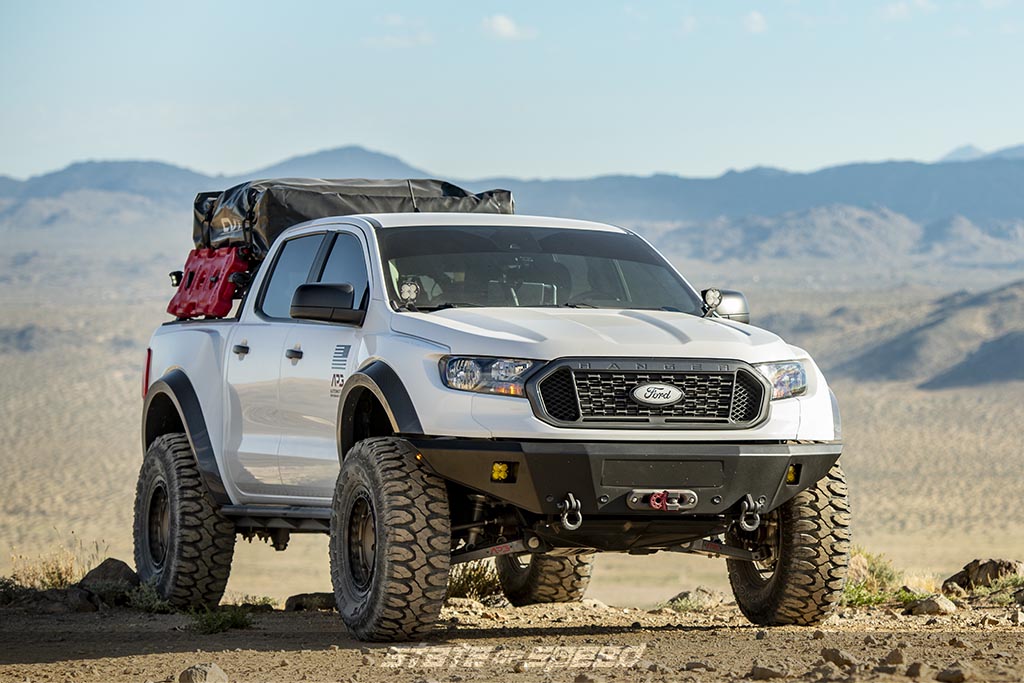
The Deciding Factor(s)
Which is the right one for you? Well, only you can really answer that question. There’s a lot to take into consideration—some are the obvious cost and labor issues, and others may be less glaring and require careful attention. You’ll have to seriously address the pros and cons of how mid- and long travel suspension systems stand to benefit your particular situation and how they could possibly negatively affect you world as well.
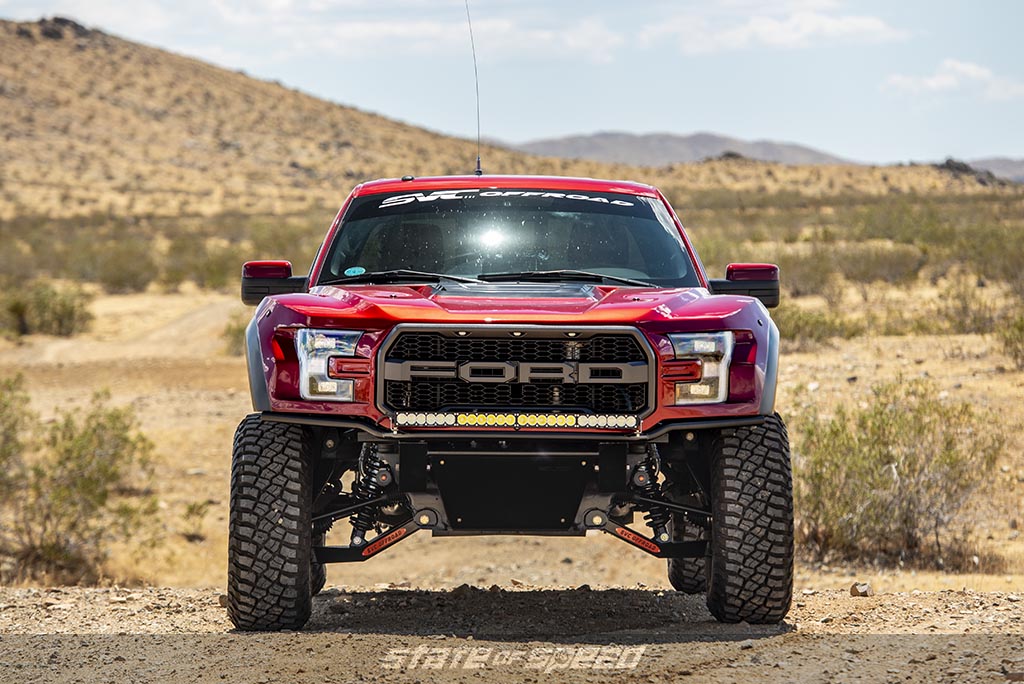
While there is no real “negative” surrounding either of these suspension upgrades as they are both far superior than factory specs if you plan on doing any type of off-roading—even in the slightest. Mid-travel setups are far more accessible than their long-travel counterparts, as most basic front kits consist of at least an aftermarket uni-ball upper control arm, a quality coilover with reservoir, an upgraded leaf spring pack, axle flip kit, and a reservoir-equipped shock. All are fairly straightforward to install, and all of these components bolt right into place.
Mid-travel setups are far more accessible than their long-travel counterparts…
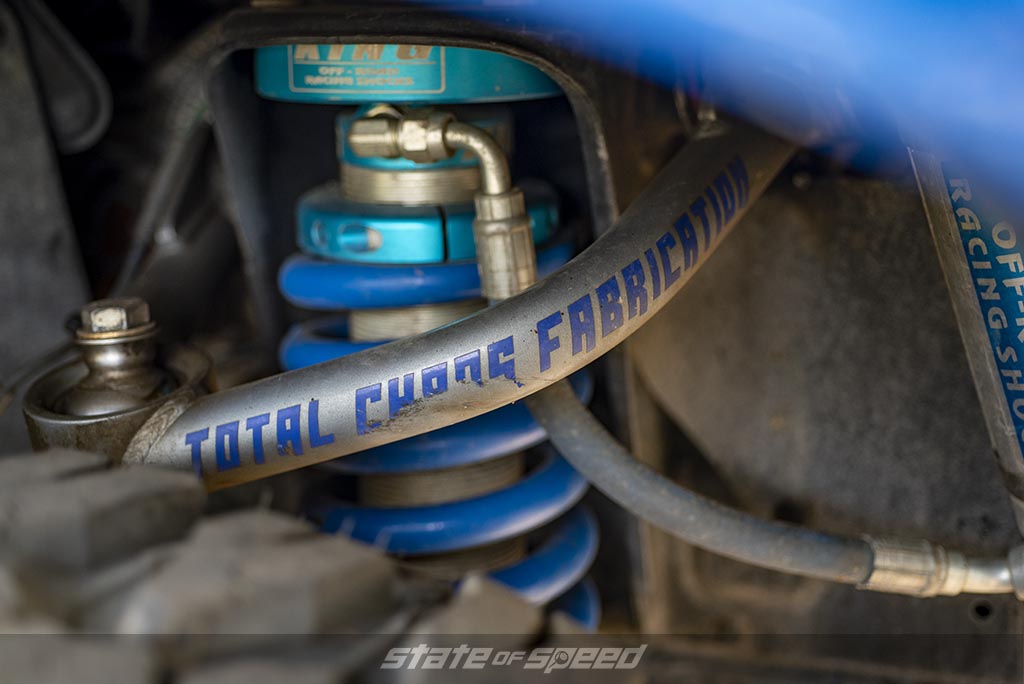
On the other end, long travel setups are far more involved as you’re looking at aftermarket upper AND lower uni-ball control arms, an extended axle shaft, tie rod extension, coilovers with reservoir, and strategic weld-in reinforcements in the way of braces/gussets for optimum strength. You’ll see a beefier leaf spring pack here at the rear, which will be placed underneath the axle. This means that bolting on shocks in their factory mounting points will not be possible. You’ll have to get creative here to make it work, whether that means relocating the mounts somewhere else of going right through the bed utilizing a bed cage. Don’t expect things to be as easy as with mid travel setups here, it’s far more work, but there is a larger payout here once the dust settles.
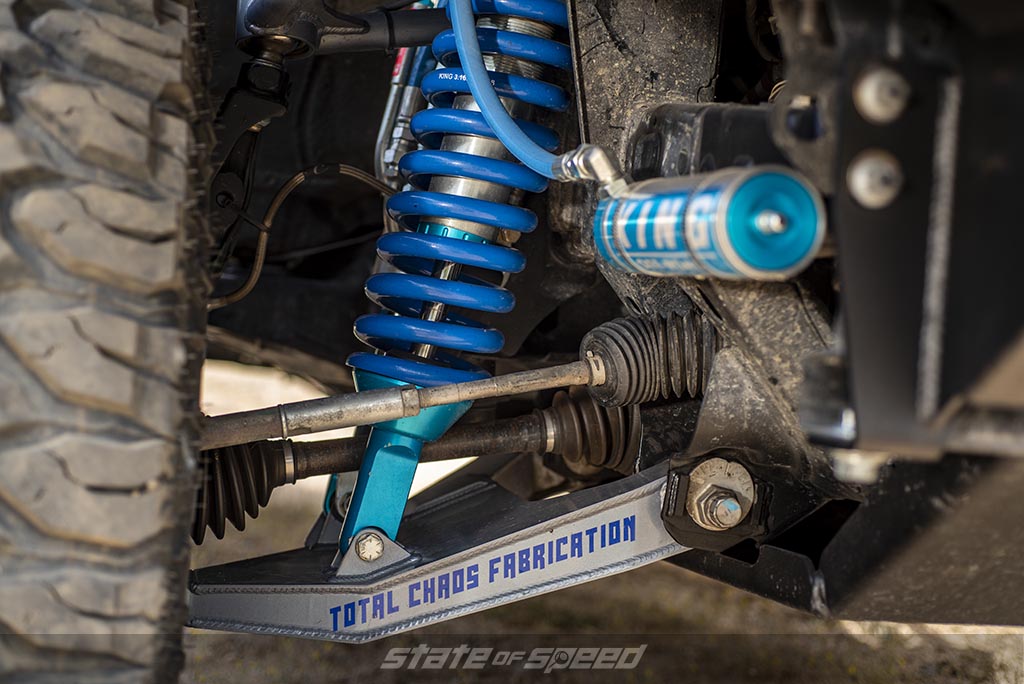
Long travel suspensions cost much more to build, obviously, but in more ways than you might think. Aside from the suspension components themselves, you’ll also have to take factory fender panels out of the equation, and think about wider, fiberglass options instead since the width of the front suspension is extended and the rear travel is extended so much over stock. On the bright side, you’ll be able to run comfortably with 35” tires without having to endlessly cut and trim until there’s nothing left of those original fenders anyway.
Type of Driving
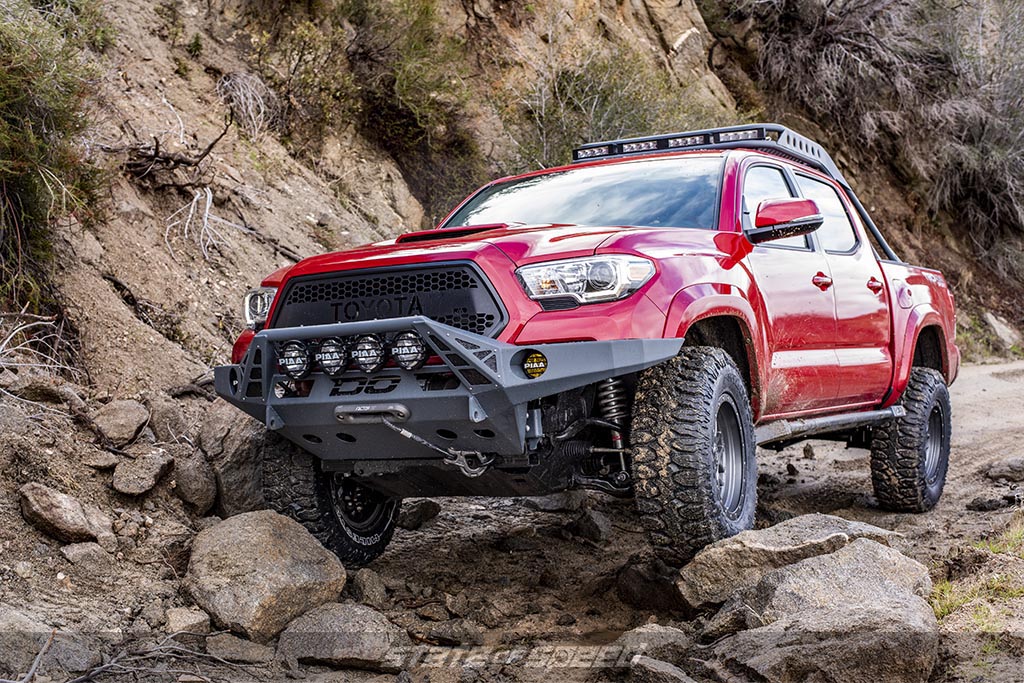
Think of mid travel suspension good for casual trail cruising, some moderate rock climbing, and increased general access to rougher conditions that wouldn’t otherwise be comfortable in a stock truck. You’ll have a lot more options open to you as far as terrain you’ll be able to take on, but take those options and multiply them—that is the true capability of long travel. But is long travel feasible for daily driving duties? Sure, why not? It’s really a personal preference with the additional width up front and all, but it’s just like anything else, you’ll adapt.
Bottom Line Pros and Cons
Let’s start with mid travel first. You’ll be able to install the suspension components comfortably at home without any specialty skills or tools. The parts involved are fewer and relatively inexpensive, and you’ll still be able to upgrade tire size—think 33s without having to cut/trim fender wells too extensively. While you’ll be able to comfortable drive your truck daily and still have more confidence off-road, you will still be limited to more extreme conditions that only a long travel will be able to handle.
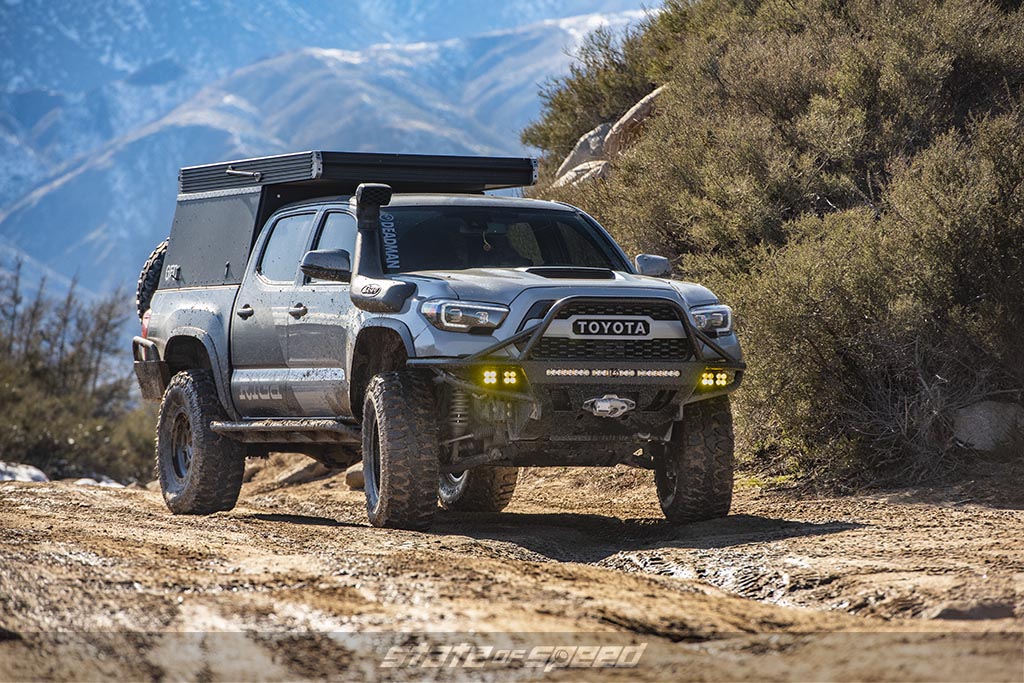
Long travel suspension parts do add up fast and installation isn’t always for the everyday DIY builder at times. You’ll most likely have to do some welding, so if you don’t have this skillset under your belt, you may have to outsource or wrangle a buddy who can help out. Save part of your budget for replacement fender panels, and prepare to lose valuable bed space for that bed cage and probably a spot to throw your spare. Don’t let all those factors stop you from seeing the job through—once everything is done, the off-road landscape will be your oyster.

…once everything is done, the off-road landscape will be your oyster…
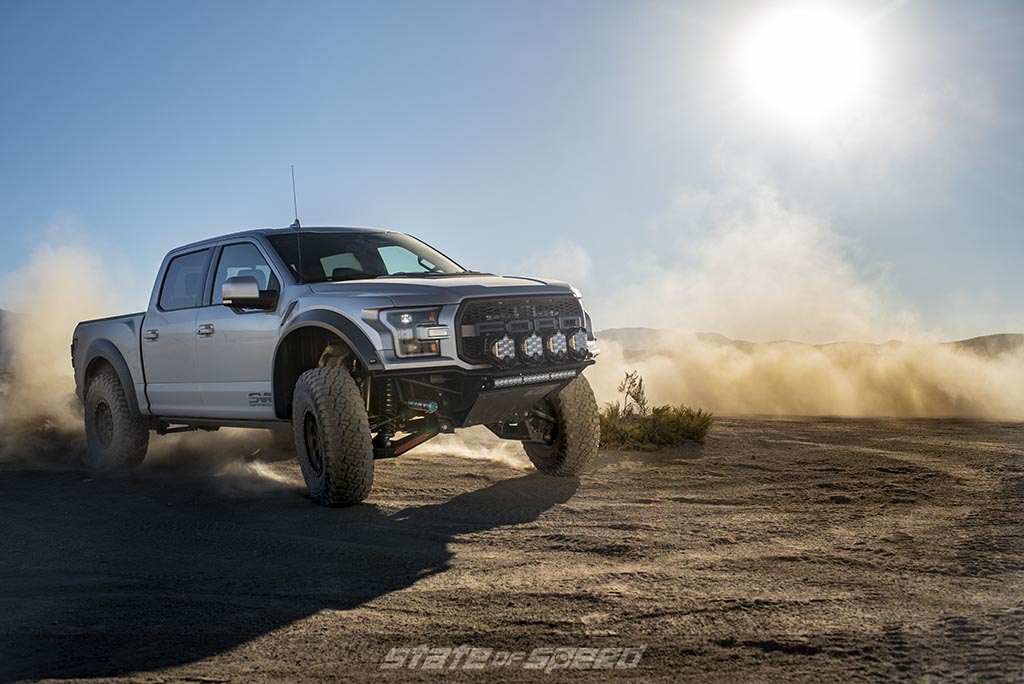
In the end, you’ll have to make the decision of just which scenario is right for you. Are you down for the higher cost and more in-depth installation of the long travel? Is it really worth the extra money and extra headaches? Are you fine with still being able to having more paths opened to you while still being limited to only where long travel-equipped trucks can travel? Weight it all out, sleep on it, talk it over with your better half, and then start building the truck that is right for your own personal situation.
Suggested Stories
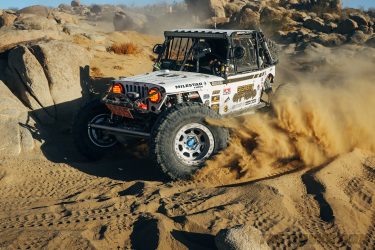
Leave a Reply Cancel reply
Your email address will not be published. Required fields are marked *
- LATEST STORIES
© 2024 STATE OF SPEED. ALL RIGHTS RESERVED

- Forum Listing
- Advanced Search
- Tundra Discussion
- Tundra Suspension Talk
"Long Travel" vs. Lift Kit
- Add to quote
o oh oh no you didn't!!!
ahhaha Long travel is awesome and once you ride in a LT truck or have one you will never be disappointed. where to start really.... im going reference camburg since I have camburg Boxed lower 4130 arms 1.5″ upper and lower uniballs, 1″ uniball lower arm pivots, heim upper arm pivots 16" of travel 3" over per side ugggghhh pretty cool if your really going use your truck. you can totally tune your front end with didfrent valving and springs.... once you get your bypass shock in there you can really back off the valving in the coilover and just use the bypass shock to take the hard hits a lot better this has been discussed a few times just search for sicky nar nar pictures
Its all suspension syber. If your gunna go big, that's the way to go. IMO
thanks guys. guess I'll just have to do my research, because everything dani7 just said, might as well of been in German. I don't speak German. Or let someone who knows what they're doing, order everything for me when the time comes. I'm planning on keeping my truck for as long as possible, so I want to do it right.
check out camburg.com they make a pretty sweet long travel set up. ive debated ditching the lowered trd susp. for some long travel. camburg built a sweet tundra about a year ago. theres a few vids on youtube of it. also chaosfab.com they make some nice LT control arms.
TundraInsider said: I love my long travel truck - It rides great on the street and you can jump it in the dirt. Go long travel! Click to expand...
C_Litt said: First of all... TundraInsider has the sickest 2nd gen LT tundra around right now. Long travel suspension is made for high speed desert runs and jumping. Typically a long travel truck wont even be that much higher from the ground then a stock truck... normally somewhere between 4 to 6 inches of lift... but the new suspension is able to cycle more inches of travel when hitting bumps and what not. Most trucks (not all) with long travel run bulged and raised fiberglass fenders and bedsides to allow bigger tires to fit and also so the suspension can cycle up further. If you can afford doing a long travel kit, go for it!... mine will someday. But unless you plan on hauling ass through the desert or hitting jumps, you most likely dont need it. Click to expand...
First of all... TundraInsider has the sickest 2nd gen LT tundra around right now. However, nobody really has answered the question properly so... allow me. and no... none of this has ANYTHING to do with body lifts at all, body lifts are garbage and should NEVER be mentioned again! lol. A typical lift kits main goal is to get the truck raised higher off the ground and to allow the clearance of larger tires. Some, but not all lift kits are made tougher than the original suspension and are made for off-roading... typically slower speed off roading. The lift gives you the ability to run larger tires and gives you better departure and approach angles on obstacles because your bumpers are higher. There is a happy medium when it comes to lifts for off-road purposes though... once you go more than 6" or 8" inches max you're center of gravity gets too high which can make the truck un-stable on off camber terrain. Long travel suspension is made for high speed desert runs and jumping. Typically a long travel truck wont even be that much higher from the ground then a stock truck... normally somewhere between 4 to 6 inches of lift... but the new suspension is able to cycle more inches of travel when hitting bumps and what not. Most trucks (not all) with long travel run bulged and raised fiberglass fenders and bedsides to allow bigger tires to fit and also so the suspension can cycle up further. If you can afford doing a long travel kit, go for it!... mine will someday. But unless you plan on hauling ass through the desert or hitting jumps, you most likely dont need it.
Thanks for this post
Thanks C_Litt! That explains it perfectly. I doubt I'll ever do any hard off roading with my truck, so I guess I don't really need the long travel. I had NO idea a CrewMax could catch air like that, Insider. 0.0
where i'm from the terrain is usually more narrow paths with big dips, rocks, and trees in your way so you need a lot of ground clearance. There aren't many areas where I have enough room to go flying off of a jump so a long travel kit doesn't make sense for me. I don't think any lift kit will be able to take the abuse that a long travel kit can though.
I had a RCD 6" lift on my 06 tundra came with bilstein 5100s all around. That truck got abused for a bracket lift 40+ mph (not fast but for a bracket lift I think it is) racing on dirt roads not maintained lots of ruts and pot holes. Truck was jumped and beat ha never broke a thing. I don't really plan on doin that with my new 2013 but when I get a 7" I do plan on testing out the fox shocks it comes with. Unless you plan on jumping your truck and don't need a high ground clearance long travel is for you ha Sent from AutoGuide.com Free App
I will also add what i know and have learned. I wish I would have went long travel in the first place living in Las Vegas we have all this desert and it screams to be driven fast in, and we have awesome trails and tons of dry lake beds. I ended up doing what most guys do and thats lifting there truck because face it a lifted Tundra looks good. What i realized later was your alot more limited on what you can do. Sure you can off road but you have to go ALOT slower so you dont brake shit, yes it does look great and def brakes necks out here in Vegas, but i realized that Long travel esp out here is just too much fun not to have. Granted now i'm gonna pay big time to get all my stuff switched over from lifted to Long Travel but honestly it's worth it in my case. Now i'd say if you live in an aread that is more wooded trails and has rocks and stuff where clearance becomes and issue then by all means a lift kit is perfect because your prob not gonna haul ass at 80mph plus down the trail. But if you live in a desert environment like I do you def Want long travel. Pricing can be tricky as well Long Travel aint cheap you have to decide if you wanna just go single rate with just coilovers in the front and rear shocks deavers and the LT kit or if you wanna go all out and run a bypass shock in the front along with a coilover, then you have to decide if you want to do a bedcage and run rear bypass shocks and run underslung leaf springs. There are alot of options with Long Travel and it def is more pricey then doing a lift kit but the ride is def priceless, and once you've expierenced it you wont look back
Listen to him hes got it right
Simple answer: lift kit is to make it sit higher(for looks) LT(long travel) is for performance, more travel in the suspension. More off road capable. Suspension has more travel to go over bumps and such at a faster speed and is more durable and strong to be able to handle the abuse of all of it, can even handle a bit of jumping. Id say Go for LT only if your going to actually use it, lift if you want for looks, you want a bit of both? Mid travel it, raise your truck and give More travel for about the cost of a lift kit
The glass fenders are cheap compared to LT - You can get the fenders for a few hundred bucks but the LT kit is a few thousand plus your coilovers plus your secondary shock and hoop. OHH and axles if your 4wd
True Story... Long Travel in a nut shellis badass but prob the most expensive setup you can run were talking between 12-20k depending on how involved you wanna get factor in the following Front Long Travel Kit w/Upper and Lower Arms/limit straps ect Coilovers Bypass shocks Hoops for bypass shocks Fab for bypass hoops Bump stops Front Glass Fenders 4WD Axles Rear Rear Shocks Bypass Shocks Bump Stops Custom Bedcage for bypass shocks or Link Setup "Costs more" Deaver Leaf Springs Rear Bump Stops Rear Glass Then if you need new wheels and tires add that into the cost plus labor and paint and your easily looking into the 20k mark It's a super badass setup and had i have had to do it over i'd went Long Travel from the beginning but now I have so much invested into my truck idk if I can really bite dropping 20k to change my whole setup. Moral of the story do it right the first time haha
Agreed!! Do it right the first time. And/or figure out a plan and stock to that plan. With my build I would just go up to the next level telling myself that was all I needed. Then when I built it there's always the devil sitting on my shoulder saying 'wow!! This is badass!! I wonder what it'd be like at the next level' sure enough I'm taking off parts and selling them at a loss to put towards new parts.
Haha thats how i feel everyday lol The kid in me wants to say screw it and do it, but the adult in me comes out and says save the money keep investing in your 401k for retirement or just buy some new sand toys or quads.
Huh well that just went from a "oh yeah just charge it on the credit card" to a "I may need to skip a few meals to afford this" real quick lol Sent from AutoGuide.com App
Haha ya I've thought long about what i want to do. I beat my last truck surprised it didn't fall apart it was a good truck. And I know how I drive off road this long travel only makes sense. It may be overkill for around here since I don't have dunes to ride around. But bada$$ factor is worth it to me haha. But I've got a $10-12k budget when the time comes. Hopefully that will be sufficient lol Sent from AutoGuide.com Free App
Here's a few links of trucks Camburg built with a price break down. These DO NOT have labor included in the price so bear that in mind. But should give u an ideas how much this stuff costs. http://camburg.com/photos/project-gallery/black-race-tundra/ Total Parts Cost = $51,104.00 (price doesn’t include installation labor costs) http://camburg.com/photos/project-gallery/mx-lt-tundra/ ****MOST COMMON SETUP**** Total Parts Cost = $20,024.00 (price doesn’t include installation labor costs) http://camburg.com/photos/project-gallery/think-inc-lt-tundra/ Total Parts Cost = $31,533.00 (price doesn’t include installation labor costs) http://camburg.com/photos/project-gallery/studio-lt-tundra/ Total Parts Cost = $24,473.00 (price doesn’t include installation labor costs) Sent from AutoGuide.com App
If you go LT hit me up fr the best pricing around!
X 2 Despized has the best prices around for LT he is the only reason I am gonna do it because his prices are great Sent from AutoGuide.com App
With an LT kit towing goes out the window correct? Sent from AutoGuide.com App
You can still tow just can't tow anything super heavy. My buddy Ryan tows his boat with his fine Sent from AutoGuide.com App
If you go sua towing capacity has to be close to stock. I can fill the back of my truck with 4 trash cans 50 gallons each with water and the suspension barely bumps out half way. At 8.34lbs per gallon that's a lot of tongue weight. Soa on the other hand, you can pull a small landscape trailer.
Just get yourself a dialed mid travel kit man. You can bash pretty hard with those. Hit up dirty deeds and he will dial you in
- ?
- 161.4K members
Top Contributors this Month
- Coil Over Shocks & Bypass Shocks for Trucks
No products in the cart.
Return to shop

- 2.0″ Coil Over Shocks
- 2.0″ Coil Over Shocks w/ Reservoir
- 2.0″ Reservoir Shocks
- 2.0″ Emulsion Shocks
- 2.0 Coil Over Kit
- 2.5″ Coil Over Shocks
- 2.5″ Coil Over Shocks w/ Remote Reservoir
- 2.5″ Bypass Shocks
- 2.5″ Emulsion Shocks
- 2.5″ Reservoir Shocks
- 2.5″ Reservoir Pin Top Shocks
- 2.5 Coil Over Shock & Spring, 2-Corner Kits
- 2.5 Coil Over Shock & Spring, 4-Corner Kits
- 2.5 Coil Over w/ Remote Reservoir Shock & Spring, 2-Corner Kits
- 2.5 Coil Over w/ Remote Reservoir Shock & Spring, 4-Corner Kits
- 3.5″ Reservoir Shocks
- 3.5″ Piggyback Bypass Shocks
- 2.5″ Springs
- 3.0″ Springs
- 3.75″ Springs
- OEM Springs
- Viper LS Valve Spring Kit
- Steering Stabilizer
- 2.0″ Bumpstops
- 2.5″ Bumpstops
- Bumpstop Kits
- Bumpstop Parts
- 2.0″ Parts
- 2.5″ Parts
- Shock Rebuild Kits
- Shock Tools
- Rod End Kits
- F-O-A 3.0 Inch Axle Mount Shock Tabs, 2-pack
- F-O-A Angled Shock Tab, 2-pack
- F-O-A Flat Bottom Shock Tabs, 2-pack
- F-O-A Shock Reservoir Mounting Kit
- Ford F250 & F350 Billet Coilover Conversion Mounts
- Billet Coil-Over Adapter
- Anodized Billet Shock Reservoir Clamp
- Coil Over Towers
- Accessories
Uncategorized
Mid-travel vs long-travel suspension.

Get more out of your off-road rig with a mid-travel or long-travel suspension kit. There are many different off-road disciplines, from a few bumpy roads, a deep mud bog, a demanding rock crawling experience, a Midwest rock bouncing event, a short course challenge, or a full out off road desert race. Compare the benefits of a mid-travel and a long-travel suspension systems to find the best option for your rig and budget. Explore quality suspension options at F-O-A before hitting the trail and making dirt-covered memories in your off-road vehicle.
Understanding Your Suspension
First, it’s important to realize there are few hard-and-fast distinctions between mid- and long-travel suspensions. You can swap out your OEM suspension with a wide range of travel options, and every kit can be adjusted to fine-tune your ride. Learn more about mid-level options that balance an OEM look with dependable off-road protection.
Kit Components
If you want to put a small lift kit on your vehicle for an off-road look, you won’t need a new suspension kit. However, for a true off-road ride, you’ll want to upgrade to a mid-travel or long-travel suspension. Here are the areas of your suspension system that you’ll need to alter to create a professional off-road ride:
- Upper and lower control arms
- Brake lines
- Limit straps
Carefully read the type of kit you pick up. Some kits come with all of these components, while others miss the coil over shocks or other features. Keep in mind that a long-travel kit and serious off-roading may require additional reinforcements, as you enjoy your new found ability to go faster on your favorite trails.
Why You Need an Upgraded Suspension
A new suspension system is all about soft landings, articulation, and higher ride height. If you’re cruising over rutted roads or sand dunes, then your stock suspension won’t be enough to protect you from the jarring ride. The addition of good Coil-over shocks are the single key difference between a comfortable ride and a bone-jarring experience. Second is the amount of suspension your rig enjoys, long travel or mid travel.
A new kit, particularly a long-travel one, gives you more articulation from full jounce to full droop. This is an essential feature in making your rig drivable in all situations in your off-road adventure. You may need to lift the body of your vehicle or use aftermarket fiberglass fenders if you wish to run larger, wider tires that give you the traction and clearance you can now use when the road takes a turn for the worst.
Installing Mid-Travel vs. Long-Travel Kits
Upgrading your suspension system can be a DIY project or a fabrication shop in your area can always do the job for you. Compare full kit fab shop installs vs. DIY installation and find out how to select mid-travel or long-travel kits from F-O-A . . . and get the information you need to settle the debate for you and your ride.
Full Kit vs. Piece by Piece
A full-suspension kit gives you the all-in-one convenience you need. Prepare for any adventure with most or all of the parts and hardware you need. Consider purchasing a full kit for your first time for convenient setup and quick installation.
Some off-roaders pick and choose shock absorbers, springs, arms and other components from various manufacturers. Use caution when mixing brands of parts, as some may not be compatible with others or have the exact specifications you need.
Mid-Travel vs. Long-Travel
A mid-travel kit is going to be more affordable than a long-travel alternative. You won’t have the same articulation, but you’ll have an affordable easy modification to improve your on and off road experience.
Long-travel suspension systems offer unbeatable articulation, surprisingly soft landings, and excellent ride ability. Compared to a mid-travel kit, these kits are a larger investment into your rig and people will notice your investment. Choose a long-travel option if you’re a serious off-roader who wants the best suspension option on the market.
Benefits of an F-O-A Kit
At F-O-A, we believe in affordable suspension kits that don’t sacrifice on quality. Compare our kits for various makes and models of vehicles for a hassle-free upgrade to your ride. Our kits use powder-coated control arms, precision-machined tie-rod extensions, and DOT-approved brake line extensions. When you need a reliable off-road package, turn to F-O-A.
The Verdict
In the end, it’s all about your personal preferences. Does an off-road trip to you mean a few rutted dirt roads and OHV trails, or are you a diehard bouldering expert looking for an industry-leading suspension system? Your driving experience will help you determine whether you need the more extended travel out there or if a mid-travel option will work well for your situation.
Shop for suspension kits at First Over All Off-Road Shock Technology. Find the long-travel and mid-travel suspension kits that fits your vehicle and your budget, if you don’t see it reach out to sales for your application. You don’t need to wait for your next paycheck . . . start your off-road adventures quickly with competitive financing options @ f-o-a.com
- Search for:
Username or email address *
Password *
Remember me Log in
Lost your password?
Username *
Email address *

- Mods 1 – Getting Started
- Mods 2 – Tire Size Guide
- Mods 3 – Tire Buying Guide
- Mods 4 – Performance
- Mods 5 – Lift & Level Kits
- Mods 6 – Grille Kits
- Mods 7 – Headlights
- Mods 8 – Fog Lights
- Mods 9 – Rock Sliders
- Mods 10 – Roof Racks
- Mods 11 – Front Bumpers
- Mods 12 – Rear Bumpers
- Mods 13 – Skid Plates
- Mods 14 – Wheels
- Switch Systems
- Rooftop Tents
- Acc Lighting
- Tail Lights
- Rock Sliders
- Skid Plates
- Front Bumpers
- Rear Bumpers
- Accessories
- Recovery Gear
- Refrigerators
- Trail Tested
- Maintenance

5th Gen Mods , Install , Reviews , Suspension , Trail Tested
Dobinsons mrr/mra suspension: 5000-mile review for 5th gen 4runner, dobinsons mrr/mra suspension: 5000-mile onroad & offroad review for 5th gen 4runner.
My lift kit was one of the biggest decisions for my build. Since I’m newer to the scene, I did tons of research upfront. There are some clear benefits to an aftermarket 4Runner lift , including increased ground clearance, suspension travel, and increased ride performance. My priorities for my suspension were focused on ride quality, value, and adjustability – and the Dobinsons MRR/MRA Suspension fit the bill.
Originally called the monotube remote reservoir (MRR) , the newly named monotube remote reservoir adjustable (MRA) suspension now offers a 3-way damping adjustment.
Although this is one of Dobinsons’ newer products (early 2020), the company as a whole is by no means new to building quality, aftermarket suspensions.
Find It Online:
- Dobinsons MRR/MRA (KDSS): Check Price
- Dobinsons MRR/MRA (Non-KDSS): Check Price
Dobinsons MRR/MRA Suspension Review
What is the dobinsons mrr/mra kit.

The most notable features that sold me on the MRA suspension are build quality, serviceability, and a full range of customization with their 3-way adjusters. To top it off, they’re Australian-made shocks which brings a level of quality to the table that many different shock companies cannot.
- Progressive valving
- Heavy-duty 56mm shock body/50mm pistons
- 60mm remote reservoir
- Upgraded sealing system for better reliability
- Single piece lower leg for added strength
- 0-3″ lift and long travel options available
- Fully threaded shock body for easy preload adjustment
- Fully rebuildable
- High-speed compression – 10 stage
- Low-speed compression – 20 stage
- Rebound – 15 stage

I went with Front 2.5″/ Rear 1.5″ coil springs so that with the additional weight, my rig would sit at about 2″/1″ with no squat. The reservoir setup provides more heat dissipation, which allows me to drive faster on rough trails without worrying about damaging the suspension components.
Is it overkill? Probably. Ultimately, I splurged because, with the right maintenance and servicing, this setup should last the life of the 4Runner.
My Parts List:
- Front coils: C59-302 – 2.5″ lift with stock weight | 2″ lift with additional 110-150lbs
- Front struts: MRA59-A700 – MRA 3-way adjustable w/ reservoir monotube (0-2″ lifts)
- Rear coils: C59-505 – 1.5″ lift with stock weight
- Rear struts: MRA59-A701 – MRA 3-way adjustable w/ reservoir monotube (0-3″ lifts)
Total cost: $2600 excluding assembly/installation.
Assembling The Coilovers
If you’re not experienced with a spring compressor or not mechanically inclined, just pay the extra $100+ to get the coilovers assembled. I wanted to learn how to do it myself and boy, did I learn.
I was too focused on the installation to capture any photos or videos of this, but this video install by Dobinsons will clearly show everything I’m about to describe below. This video captures the full end-to-end coilover assembly process so I definitely recommend watching it.
In order to tighten the bushings to the top mount assembly, you need to remove the rebound adjuster bolt. This is so you use an Allen wrench to hold the shock body in place while tightening the nut and not damage the shock internals by letting the body rotate around.
Inside the threaded body, there’s a grub screw held in place by a tiny spring-loaded ball bearing. Both the spring and ball bearing will come flying out and disappear on your garage floor forever if you’re not careful. Fortunately, the kit comes with extras for each strut if you lose them.
Bottom line, if you don’t want to go through the hassle, get the coilovers assembled by a professional for peace of mind.
Mounting The Reservoirs

Note: Front reservoir tucked behind the splash guard
To mount the front reservoirs in their most optimal location, you will need to drill into the frame. Dobinsons includes diagrams and the required brackets/hardware to properly install the reservoirs. If you’re not prepared or willing to do this, be ready to get creative mounting the brackets to factory holes. The recommended placement prevents any potential rubbing and routes the reservoir hose to avoid pinching or snagging on other suspension components.
The nice thing about the placement of the front reservoirs is that they can hide behind the splash guards. The downside, however, is that it’s a little more awkward to reach the adjusters. This can be mitigated by using the adjuster tool that comes with the kit.

Note: The fuel tank skid bracket is bent back to accommodate the compression adjuster knobs
The rear reservoirs were much easier to mount, with the exception of the driver-side reservoir that wouldn’t clear the fuel tank skid bracket.
If you have aftermarket skid plates, you may not run into this issue. I had to bend the bracket back quite a bit just for the adjuster knobs to clear and spin freely. In hindsight, it would have probably been better to take an angle grinder to it and trim it down.

Installing the front struts is a tight squeeze. The rebound adjuster barely clears the captive nut for the body mount on the top of the wheel well. If you forget to reinstall the rebound adjuster before getting the strut mounted, you’re going to have a bad time (ask me how I know).
Dobinsons recommends shaving down the nut to allow for full clearance. I haven’t found the need to do it yet but may do so in the future.
Using The Adjusters

Note: Once your reservoir is mounted, the adjuster knobs will be hard to reach. Use the adjuster tool to make your life easier.
Using the adjusters is simple. The high and low-speed knobs are located on the reservoir. You can adjust by hand or use the all-in-one adjuster tool that comes with the kit.

Note: Rear shock rebound adjusters face inward from the wheel.
To adjust the rebound on the front, twist the knob on the top of the strut mount. However, the rear rebound adjuster is found at the bottom of the shock and requires the adjuster tool or flathead to turn. Additionally, the dust boot on the rear shocks covers the adjuster and becomes inaccessible if you zip tie the boot down.
I would suggest loosely securing the zip tie over the dust boot so you can easily move it out of the way for future adjustments.
Dobinsons MRA Adjuster specs:
- LSC – 3
- HSC – 5
- Rebound – 10
- LSC – 1
- HSC – 1
- Rebound – 7
These were the suggested “comfort” settings from Dobinsons with no load. I kept the same settings with a fully loaded rig, and it was still quite comfortable.
Since my last overlanding trip, I’ve reduced the front rebound to 8 and increased the front LSC to 4. Even with adding another 100+ lbs with my drawer system, the springs did not seem to settle much, if at all.
5000-mile Driving Review

The first and most obvious change is that this setup is noticeably stiffer than stock. This is because the Dobinsons stock weight springs can still carry more weight than OEM springs. Thus, if you don’t have additional constant weight, then you’ll feel the stiffness as well. It was by no means harsh, but it took some adjusting.
The main reason most people change out their stock suspension on the 4runner, besides clearance and looks, is to reduce or eliminate body roll and nose dive. This kit did that, and still allows for a full range of adjustability if anything feels too stiff.
Another noticeable change was with high-speed compression damping. I drove on both forest roads and washed-out roads, and this setup seemed to just float over all of it with no issue.

My rig is not being built to be a rock crawler. Before I upgraded to the Dobinsons, I drove on some mild off-road trails in Utah and Washington on stock suspension. The first trail I did with the new setup was moderate difficulty and quite a step up from anything I’d done previously. We drove up steep and muddy switchbacks with some off-camber rocky sections to reach an alpine lake. The before and after comparisons were pretty night and day in my opinion.
Driving over gravel and small rock sections were a breeze and way less jarring. Over rutted sections with large rocks, I was fully flexed yet planted. I rarely had a tire leave the ground despite taking a bad line. The added travel gave me total confidence. I didn’t adjust any of the damping settings because I didn’t think the trail would be that technical. However, I definitely will next time so the ride is more compliant over larger obstacles. Ultimately, the suspension took everything like a champ!
Final Thoughts

I think this lift kit checks all of the boxes I was looking for: quality, value, and adjustability.
My only gripe about the MRA kit is that it was made for universal fitment. Thus, the reservoir hoses for the front shocks are excessively long at 2 feet. Make sure you’re careful about how you’re routing the hoses to prevent damage or obstruction to the other suspension components.
Something to note is that Dobinsons does not have a set rebuild mileage or timeframe. Your driving habits will play a large role in terms of lifespan. If you are hitting moderate to difficult trails frequently, your shocks will obviously need to be rebuilt far sooner than a daily commuter. However, Dobinsons uses the best possible seals and fittings for longevity. I’ll see if this statement stands up to the test of time.
Compared to other competitors such as Icon, Kings, OME, and Elka, the Dobinsons’ price point is hard to beat. They also seem to be much more readily available with little to no lead times. If you’re itching to get your suspension upgraded quickly, this might be your answer.
Born and raised in the Bay Area, went full-send PNW and settled in Seattle. Likes: coffee, whiskey, hiking, snowboarding, camping, grilling/cooking. Outdoor adventure seeker sharing experiences of his first 4runner build.
Thanks a lot for the article Dan.

On the rear, it was even worse. The reservoir on the driver side is located behind the wheel well and on the passenger side is located under the rear passenger door on the frame. I do not like either location. The reservoir location on the rear driver side will get in the way of a rear bumper bracing and the right the passenger side the location is no ideal to have access to adjust the reservoir. To fix this, I ordered the rear brackets from King which attach with the bump stop and will route the hose towards the back and use taping screws and the rubber bracing provided to secure it.
All in all, this is not a deal breaker for me. I am very happy with the suspension and the lift it provides. Have yet to test the rig off road. Still working on the build.
I replaced the suspension myself and I am not mechanically inclined so it took some time but it was a great experience for me.
I went with: Dobinsons 1″ to 3.5″ MRR 3-WayAdjustable Lift Kit Toyota 4Runner 2010-2022 (Non KDSS) Front Shocks: MRA59-A574 3-wayAdjustable Shocks Suits 2.5″-3.5″ (No extra pre-load) (I will add some pre-load once the rig is loaded with bumpers, winch, etc.) Front Springs: C59-302 – 2.5″ Lift Stock Load, 2″ w/150LBS Added Load. Rear Shocks: MRA59-A701 3-WayAdjustable Shock suits 0-3″ lift. Rear Springs: C59-325 – Stock rear end, 2.5″ lift.
Tires: KO2 285/70/17 (33″) on TRD wheels. I noticed the gas mpg reduction. I was getting 17/18 mpg on mixed city and hwy in town. driving. Now I am getting low 16 mpg in mixed city & hwy driving. I never got the rig thinking about gas efficiency. Reliability and Overlanding were the driving factors.
“If you want to play, you got to pay.”
Hope you see this post! I am looking into doing your exact setup, with the extended front coils, but the regular rear shocks. Dobinsons recommends replacing the UCAs with the extended front end. Did you replace the control arms or leave them stock?
Thanks so much for your detailed post!
What did you pay including install? Thanks. I’m new too.
I bought all dobinson part directly with Dobinson USA. Prices are listed on website. It varies depending on what you want or can afford.
I did install it all myself. First time doing something like that. I watched numerous YouTube videos on suspension installation.
What tire size are you running? could you put a small 33′ with this suspension?
Yep definitely! I’m running 285/70r17s with -10 offset. Did a mud flap delete, BMC, pushed the fender liner forward, and minor front bumper trim. I would have gone with 33×12.5 but I would have rubbed on the UCAs.
Doesn’t mounting the reservoirs inside the frame rail and near the headers eliminate the advantage of remote reservoirs?
That’s a good point – but honestly haven’t noticed any decrease in performance, especially since I’m not doing any baja racing. Like I said MRRs in the front is probably overkill for my application, but I figured why the hell not. For what it’s worth, Dobinsons said that these shocks perform optimally at higher temps.

Great article Dan! I plan to go Dobinson on my next lift. Your article helped solidify my decision 🙂
Thanks Ben! Glad it was helpful.
- Get Free Parts & Get Paid! Apply to Write
GET 20% OFF
Take up to 20% off at the trail 4runner store.
Log in or Sign up

- Search titles only
Separate names with a comma.
- 1247782464" id="search_bar_group_pages_after" class="AutoChecker" data-uncheck="#search_bar_nodes" /> After page 1
- Display results as threads
Useful Searches
- Recent Posts
You are using an out of date browser. It may not display this or other websites correctly. You should upgrade or use an alternative browser .
Welcome to Tacoma World!
- Participate in all Tacoma discussion topics
- Communicate privately with other Tacoma owners from around the world
- Post your own photos in our Members Gallery
- Access all special features of the site
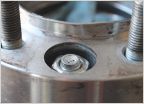
Long travel vs Suspension lift
Discussion in ' Long Travel Suspension ' started by bulldogs123 , Jul 15, 2009 .
#1 bulldogs123 [OP] Member

What are the pros and cons of a long travel kit or a suspension lift(looking at a 6inch)? I like to go off roading alot. There are trails that I like to go down with hills and it's fairly rough terrain at certain spots. The fields get real muddy after a rain. I'm looking for something that will perform awesome offroad and be a good daily driver too. I will be getting a 2009 taco 4x4. I was looking at the camburg long travel kit with the arb deluxe brush bar bumper. I'm pretty in familiar with the long travel kit. Does it lift the truck any and what size tires would clear? Any help or suggestions would be greatly appreciated! Thanks, Shawn
#2 Delmarva Mayor of TW

I can't really help you other than to say with the camburg kit, you'll need fiberglass fenders to clear the tires (me thinks 35s, but could be wrong)... Allpro LT kit lets you keep stock fenders...
#3 toku58 Well-Known Member
Well if you're deciding between a DB 6" lift or the LT kit? No comparison! Take the LT kit! My vote will be for All Pro! DB is decent for offroading, but nowhere near the LT kit. From good to best! -3" lift (limited down travel after lift) -6" DB lift (Just a little better than a 3" lift because you keep 100% of the suspension articulation) -LT kit (Increased articulation, but much wider front wheel base (Maybe an issue for a daily driver) -SAC (Sky's the limit)
#4 j1999t Well-Known Member
what is an SAC?
#5 sincitytaco Well-Known Member
Solid Axel Conversion.
#6 RelentlessFab Eric @Relentless Fab Vendor
I'd go long travel for serious offroading. The DB lifts are okay for offroad, but are more for looks and to be able to fit larger tires, whereas the LT kits are all about suspension performance. The increased articulation you get out of a LT setup and increased ground clearance will dominate any 6" lift. Oh, and yes, 35's fit with a little trimming on the Longtravel. I'd vote allpro for the longtravel from what I've seen of their new kit.
#7 MonkeyProof Power Top

if you do trails like i do, and if you are thinking about a LT kit...seriously take consideration into the All-Pro Long Travel Kit.. i have it and all i can say is my truck is now in a class of it's own. it's only 2" wider on each side so you wont have to have fiberglass finders, and it's not too wide for the tight trails...this kit handles great so far, the steering great...on my first run on it throught the desert i got confident enough with the kit i was pulling 4wheel drifts coming out of turns like it was nothing..total control Dukes of Hazard style haha..and, i could go as fast as i dared to while not bouncing all over the place... on the trail it's even better...like a mini SAC haha...the amount of up and down travel is insane and the articulation is crazy...a good example on how it did on the first trail run this past sunday...my buddy with his FJ on 35's with his front/rear locker engaged was having some trouble getting up and over some rocks..took him some work and lining up several times but he eventualy struggled over them...when i came up using his same exact line i made it up and over the first time like it was nothing..reason being, the way the front was articulating kept the wheels on the ground for traction..no 3wheeled stands like my buddies FJ..of course i had my rear locker engaged but still.. here's some teaser pics of the kit...pics taking by http://www.SiRMarlon.com these pics taking sunday at cleghorn..only 2 cuz everybody is lazy to get em uploaded haha...taking by BillDozer (TTORA) making the easy line hard..just testing on how stable the new track width is haha and...look at all that ground clearance
#8 imsikotic If u cant stand behind our troops. Stand in front

I would say go with the Camburg Long Travel setup. FTW!!!!!!!!
#9 MonkeyProof Power Top
^...haha, great generalized answer...care to elaberate some more
#10 mjp2 Living vicariously through myself Moderator
#11 Blaise22 Well-Known Member
MonkeyProof said: ↑ if you do trails like i do, and if you are thinking about a LT kit...seriously take consideration into the All-Pro Long Travel Kit.. i have it and all i can say is my truck is now in a class of it's own. it's only 2" wider on each side so you wont have to have fiberglass finders, and it's not too wide for the tight trails...this kit handles great so far, the steering great...on my first run on it throught the desert i got confident enough with the kit i was pulling 4wheel drifts coming out of turns like it was nothing..total control Dukes of Hazard style haha..and, i could go as fast as i dared to while not bouncing all over the place... on the trail it's even better...like a mini SAC haha...the amount of up and down travel is insane and the articulation is crazy...a good example on how it did on the first trail run this past sunday...my buddy with his FJ on 35's with his front/rear locker engaged was having some trouble getting up and over some rocks..took him some work and lining up several times but he eventualy struggled over them...when i came up using his same exact line i made it up and over the first time like it was nothing..reason being, the way the front was articulating kept the wheels on the ground for traction..no 3wheeled stands like my buddies FJ..of course i had my rear locker engaged but still.. here's some teaser pics of the kit...pics taking by http://www.SiRMarlon.com these pics taking sunday at cleghorn..only 2 cuz everybody is lazy to get em uploaded haha...taking by BillDozer (TTORA) making the easy line hard..just testing on how stable the new track width is haha and...look at all that ground clearance Click to expand...

#12 mjp2 Living vicariously through myself Moderator
bulldogs123 [OP] initial post: ↑ What are the pros and cons of a long travel kit or a suspension lift(looking at a 6inch)? I like to go off roading alot. There are trails that I like to go down with hills and it's fairly rough terrain at certain spots. The fields get real muddy after a rain. I'm looking for something that will perform awesome offroad and be a good daily driver too. I will be getting a 2009 taco 4x4. I was looking at the camburg long travel kit with the arb deluxe brush bar bumper. I'm pretty in familiar with the long travel kit. Does it lift the truck any and what size tires would clear? Any help or suggestions would be greatly appreciated! Thanks, Shawn Click to expand...
#13 imsikotic If u cant stand behind our troops. Stand in front
MonkeyProof said: ↑ ^...haha, great generalized answer...care to elaberate some more Click to expand...
#14 jonny Betty White Edition Heep ZJ
not to bench race here...but it "seems" that the allpro LT kit is aimed for the rock/trail enthusiast and the camburg /TC LT kits are aimed towards desert running. I also couldn't find how much travel you gain with the allpro LT kit on their page. Camburg and TC both have the travel listed and looks like a little more track width. MP def came up on this deal. Congrats man! looks good.
#15 MonkeyProof Power Top
imsikotic said: ↑ Calm down turbo. I'm not knockin All-Pro at all. No need to be defensive. I actually like their stuff. And I love your truck. Just my preference is for Camburg . That is the setup I am getting in the near future. I'm also into prerunning and it looks like you are into that and crawling. I want the extra width and travel. I want to run glass fenders and bedsides. Plus I know their work, I like the company and I get a discount. Click to expand...
#16 BeachBoy Well-Known Member
toku58 said: ↑ From good to best! -3" lift (limited down travel after lift) -6" DB lift (Just a little better than a 3" lift because you keep 100% of the suspension articulation) -LT kit (Increased articulation, but much wider front wheel base (Maybe an issue for a daily driver) -SAC (Sky's the limit) Click to expand...
#17 imsikotic If u cant stand behind our troops. Stand in front
I agree with you MonkeyProof, most of these companies got some good shit. BeachBoy. You forgot 4-link in the rear for crawlers and prerunners.
#18 MonkeyProof Power Top
jonnysrt2004 said: ↑ not to bench race here...but it "seems" that the allpro LT kit is aimed for the rock/trail enthusiast and the camburg /TC LT kits are aimed towards desert running. I also couldn't find how much travel you gain with the allpro LT kit on their page. Camburg and TC both have the travel listed and looks like a little more track width. MP def came up on this deal. Congrats man! looks good. Click to expand...

#19 BeachBoy Well-Known Member
nice vid!! The blue DMZ trucks seems to have the better setup, or is it an illusion? I am looking at the trucks bouncing and it seems the blue one bounces the least.
#20 imsikotic If u cant stand behind our troops. Stand in front
i would watch the vid if the damn internet over here in Iraq didnt suck so bad.
Products Discussed in Entire Site Forum: Long Travel Suspension
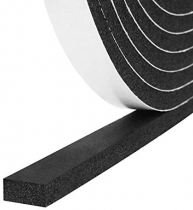
- No, create an account now.
- Yes, my password is:
- Forgot your password?

- Forum Listing
- Marketplace
- Advanced Search
- General RZR
- RZR 800 Specific Discussion
Long Travel vs Lift Kit
- Add to quote
Hello everyone... I have owned a stock 2010 rzr 800 for a few years now. I have bassically rode the crap out of it. It was recently submerged in a swap almost to the top of the roll cage and the engine is drowned. With that being said it is now in the garage and being tore apart. I figured while i am here i may as well do some upgrades. SO my question is should i go with a long travel suspension or a lift kit? I am looking at the super ATV rzr to rzr s conversion or their new 6 in lift kit. I mainly tool around trails on my property on the weekends and the occasional swamp ride to try to make it through.....hence the swamped out rzr. Any suggestions are welcome... thanks
My profile picture shows mine on the right. Its a 2010 RZR800 Walker Evans.
Thanks and to be honest i am not sure why that big of a lift would be good either. i just saw it today on their website and went hmmmm that looks neat.
Mine sits nice and stout with this setup. I did the +1.5 offset on the conversion kit by the way. Gives me a 3" longer wheelbase.
Awesome are you running your stock shocks and springs or did you get the kit with the phantoms? My shocks and springs are junk i can sit on the front of my rzr and almost bottom it out. (and i am about 170lbs)
If you have any questions or would like a quote don't hesitate to send me a PM and I'll get you hooked up with a great deal on anything you need.
See SuperATV is on top of it. :rofl3::rofl3::rofl3: You guys rock!!! No I ended up running a new set of Walker Evans shocks because I have a WE LE RZR and wanted it to stay true to that. I'm hearing the Phantom setup is real nice for the price. If you like mud like it sounds like you do, buy the +1.5 offset kit because it will give you extra room for bigger tires later on.
One other thing, buy the complete axels. That way you don't have to mess with the CV mess.
- ?
- 142.2K members
Top Contributors this Month
- Safety Equipment
- Hardware / Replacement parts
- King Shocks Products

3rd Gen 4Runner Long Travel Suspension
- Regular price $2,849.00
At 4.5” wider per side and 1” forward for extra firewall clearance, this kit allows up to 15” of useable wheel travel. Weak upper balljoints are replaced by 1” FK uniballs, and stock rubber bushings are replaced by durable polyurethane or optional heims for alignment adjustability.
For 4WD kits, we build custom CV axles with heat treated 300m axle shafts and machined / rebuilt / rebooted OEM CV joints for added articulation and strength. Axles come completely assembled and ready to bolt on.
Kit includes: boxed upper and lower control arms with Energy poly bushings, tie rod extensions, extended steel braided brake lines (replaces hard and soft sections of stock lines), spindle to upper uniball adapters, and custom coilover top brackets. Arms come raw or powdercoated gunmetal grey. Adjustable upper arms equipped with FK heims available as an option.
*Custom coilovers can be added to your order, message or email us for details!*
Rock crawling, trail running or prerunning a race course, this suspension does it all!
Fits 6 lug trucks only!
8-12 week lead time, depending on options, order volume and availability of materials. Built to order, all sales final.
- Bed Cargo / Accessories
- Bypass Racks
- Electronics
- Engine/Performance
- Bronco Bumpers
- Bronco Suspension
- Bronco Engine/Performance
- Bronco Tires
- Bronco Wheels
- Completed Builds
- Raptors Gen 1 Raptor Bed Cargo / Accessories Bumpers Bypass Racks Electronics Engine/Performance Lighting Suspension Tires Wheels Gen 2 Raptor Bumpers Bypass Racks Electronics Engine/Performance Fiberglass Lighting Suspension Tires Wheels Gen 3 Raptor Bumpers Bypass Racks Electronics Engine/Performance Fiberglass Lighting Suspension Tires Wheels
- F-150 F-150 Bumpers Lighting Suspension Tires Wheels
- Ranger Ranger Bumpers Suspension Engine/Performance Wheels
- Super Duty Super Duty Bumpers
- 2021 Ford Bronco 2021 Ford Bronco Bronco Bumpers Bronco Suspension Bronco Engine/Performance Bronco Tires Bronco Wheels
- Apparel And Gift Cards Tees View All Headgear View All Outerwear View All

SVC Offroad Mid Travel Kit - Gen 2 Ford Raptor
- 16" of Wheel Travel
- Minimal Welding Required
- Retains Factory Coilbucket
- Ken Block Tested and Approved
What you get
- SVC Upright
- SVC Tie Rods
- SVC Shockmount
- SVC Top-hat
- Stainless Steel Brake Lines
- Fox Or King 3.5" Bypass Shock
- Fox Or King 2.5" Coil-Over
- Custom Springs
- RCV IWE Delete
- Shanked Grade 8 Hardware
OVERVIEW: SVC Offroad's 2017+ Ford Raptor Gen 2 Mid Travel Kit offers you long travel performance without the headaches of going full long travel. We've taken what we liked about our dual shock LCA setup and upped the ante to provide Raptor owners a bolt on kit that allows superior damping control, additional ride height and ground clearance without sacrificing one bit of daily driver duties.
We've designed our Mid Travel Kit using the latest in C.A.D. technology to ensure the absolute best suspension geometry possible and coupled it with thousands of miles real-world testing to dial in shock valving and proper springs rates. We're 100% confident we have developed a kit that is unparalleled in performance, at a price that is hundreds, if not thousands less than other kits on the market.
NOTE: ALL GEN 2 MIDTRAVEL KITS WILL COME WITH OUR NEW BILLET UPPER CONTROL ARM AS SHOWN IN MAIN PIC

IMAGES
VIDEO
COMMENTS
Lift kits also allow for larger tires, increasing traction in certain conditions, such as mud or snow. 2. Performance: Long travel suspensions offer superior performance when compared to lift kits due to their increased damping compression control and ability to adjust ride height, damping and spring rates according to personal preferences or terrain conditions encountered while off-roading.
Most mid travel systems for this platform will net around 10 inches of suspension travel with just an aftermarket UCA and coilover. Most long travel systems for this platform will net 13 inches or more of suspension travel. And depending on the components, some can attain as much as 18 inches of travel, all while retaining four wheel drive.
5. LSK (+4.5″) LSK makes a couple of monster long travel kits; a race kit for 2wd Tacomas pushing almost 16″ of travel, a spindle bolt-on kit for 2wd trucks pushing 14″ of travel, and a kit for 4wd rigs also pushing 14″ of wheel travel.
Let's talk Long Travel Suspension. Suspension is the separation and connection to the ground below us, and (like most things overlanding) can be upgraded. These upgrades provide more lift and more ground clearance, and give us more adjustability and comfortability on the road and trail. Suspension upgrades run the gamut of simple spacer lifts ...
Both Expedition and Race Series kits offer 3″-4″ of vehicle lift with adjustable long travel specific coilovers. +2″ Expedition Series kits will cycle about 11.5″ of wheel travel while the wider +3.5″ Race Series will cycle about 12.5″. ... Stock width extended travel shocks do not work with a long travel kit. All TC lower control ...
This video goes over the differences between our three different types of front suspension systems; mid travel kit, long travel kit, and long travel race kit...
Mid-travel setups are far more accessible than their long-travel counterparts…. On the other end, long travel setups are far more involved as you're looking at aftermarket upper AND lower uni-ball control arms, an extended axle shaft, tie rod extension, coilovers with reservoir, and strategic weld-in reinforcements in the way of braces ...
The extra width from a long travel kit is almost like upgrading to a whole new side-by-side. You get more stability, more travel, and room for bigger tires. The stability is easy to understand: being 6 to 12 inches wider makes it harder to tip over. And when your machine is harder to tip over you can ride faster and turn harder.
The wider track also gives the 4Runner a better stance and stability off-road as well. And lastly, you can't forget about that look! 3. AB Castro ( @Dj_ayybeats) - 2005 SR5 2WD. Long Travel Suspension Details. Front: Dirt King 3.5+ Long Travel Kit. Dirt King Upper Arm Sheer Kit. Dirt King Bypass Shock Hoop Kit.
A long travel kit is a complete suspension replacement. It comes with everything you need to make your off-road vehicle wider, stronger, and more stable than stock. Long travel kits are designed to dampen the effects of rough riding. The extra width provides stability and makes your machine harder to tip, so you can approach turns at higher speeds.
Simple answer: lift kit is to make it sit higher (for looks) LT (long travel) is for performance, more travel in the suspension. More off road capable. Suspension has more travel to go over bumps and such at a faster speed and is more durable and strong to be able to handle the abuse of all of it, can even handle a bit of jumping.
Long Travel Suspension Fundamentals. A basic kit should include several critical components: Longer upper and lower control arms that push the wheels farther away from the vehicle's center line, up to 6 inches per side, allowing the wheels to vertically move farther. Longer coilover front shock absorbers with remote reservoirs that have ...
Mid-Travel vs. Long-Travel. A mid-travel kit is going to be more affordable than a long-travel alternative. You won't have the same articulation, but you'll have an affordable easy modification to improve your on and off road experience. Long-travel suspension systems offer unbeatable articulation, surprisingly soft landings, and excellent ...
0-3″ lift and long travel options available; Fully threaded shock body for easy preload adjustment; ... I think this lift kit checks all of the boxes I was looking for: quality, value, and adjustability. My only gripe about the MRA kit is that it was made for universal fitment. Thus, the reservoir hoses for the front shocks are excessively ...
I'd go long travel for serious offroading. The DB lifts are okay for offroad, but are more for looks and to be able to fit larger tires, whereas the LT kits are all about suspension performance. The increased articulation you get out of a LT setup and increased ground clearance will dominate any 6" lift.
Re: Lift kits: A-Arm vs. Long Travel Thanks! Ok, so next question: my understanding is that 1) the long travel and other suspension kits only address the front end and that 2) if I am going to put a heavy duty rear seat (the one that I have my eye on has a REAL fold down, diamond plate wall cargo bed) that I will need heavy duty rear springs ...
Long Travel vs Lift Kit. Hello everyone... I have owned a stock 2010 rzr 800 for a few years now. I have bassically rode the crap out of it. It was recently submerged in a swap almost to the top of the roll cage and the engine is drowned. With that being said it is now in the garage and being tore apart. I figured while i am here i may as well ...
3rd Gen 4Runner Long Travel Suspension. $2,849.00. Finish. Drivetrain. UCA Option. Quantity. Add to Cart. At 4.5" wider per side and 1" forward for extra firewall clearance, this kit allows up to 15" of useable wheel travel. Weak upper balljoints are replaced by 1" FK uniballs, and stock rubber bushings are replaced by durable ...
Find the right long travel kit for your vehicle today, and start feeling the benefits of a smoother, more tuned suspension on your UTV ASAP! Gallery. Showing 1 - 9 of 9 results. Long Travel Kit Can-Am Defender. SKU LTK-C1D-1-B. Price: $5,170.00. Add To Favorites. Long Travel Kit Can-Am Defender XMR. SKU LTK-C1DXMR-B.
Was wondering if you guys will be doing Mid-Travel or Long- Travel kits and what companies to. I'm waiting personally for my Radflo 2.5 coilovers to come in and equip it either with SVC's Mid travel kit which might be till the end of the year or Evil Mfg'a mid travel kit coming out soon around the summer.
In this video, we explore some of the unique suspension features that make the APG ProRunner suspension the best Ford Bronco Long Travel Lift Kit on the market.
Latest News & Events. Baja Kits News; Apr 15 2024 2024 Chevy Silverado FOX Factory Edition x Baja Kits 2024 Chevy Silverado FOX Factory Edition x Baja Kits What do you get when you combine 50 years of off-road racing and the industry's top performance manufacturers? A truck that has reimagined what a turnkey, desert dominating ½-ton can be. This is the 2024 Chevy Silverado FOX...
SVC Offroad's 2017+ Ford Raptor Gen 2 Mid Travel Kit offer your Ford Raptor the best performance possible with incredible amounts of wheel travel. The svcoffroad mid travel now comes with a billet upper control arm and works with both King or Fox racing shox. SVC features a 2.5 Coilover and 3.5 twin tube bypass shock.